
OhBaby!
the planner From Baby Bump to Baby’s First Birthday 2019-2020 Everything
a High Desert Media Group Publication
Staff
PRESIDENT & PUBLISHER
Steve Hunt
EDITOR
Robin Good
ADVERTISING DIRECTOR

Steve Nakutin
SALES:
Lisa Woodhart
Danial Gardner
Jessica Lopez
Cynthia Brudnak
Irene Gaulke
Andrew Covarrubias
DESIGN & PRODUCTION
Gus Candanosa
For more information or to get a copy of Oh Baby! contact Lisa Woodhart at 760.951.6253 or email lwoodhart@vvdailypress.com

Oh Baby!
2 | Oh BABY!
2019-2020






















Oh BABY! | 3
Getting Ready for Pregnancy
What most couples don’t realize when considering a baby is that it involves a lot of thought and planning. It’s not enough to be mentally ready – you have to be physi cally ready (fit), and healthy. This gives you a head start to having a healthy pregnancy and a healthy baby.
How to get Pregnant
As many of you know, conception is not as easy as it seems. While a few get lucky and conceive quickly, for oth ers it can take longer than anticipated - sometimes years. By making a few healthy choices and lifestyle compromises you can increase your odds of getting pregnant. From eating the right foods, to losing weight and cutting down on caffeine and alcohol, you can make a direct impact on your ability to conceive.
If getting pregnant is high on your priority list, here is what you can do to increase your chances:
Eat Healthy
There is nothing like a well-balanced diet to trigger your baby making process. Make sure to get ample doses of protein, zinc, iron, and Vitamin C to enhance your chances of conception.
Say no to Smoking
Smoking affects fertility and also damages the ovaries. If you are considering pregnancy there is no better time to kick the habit!
Avoid Stress
High stress levels can wreak havoc on your hormonal system, thereby affecting ovulation and conception.
Fitness Matters
Exercise regularly. Walk, swim, cycle, or hike. Anything that gets you up and moving will do the trick. Being un derweight or overweight can make conception harder and affect your baby’s health.
Keep Away from Alcohol
An occasional drink may not majorly impact fertility, but research has shown that alcohol impairs fertility and harms the developing fetus.
Frequency
Have frequent sex to increase your chances of concep tion. Most fertility experts feel that infrequent sex at the best time of the cycle is one of the most common causes of infertility.
Get to Know your Ovulation Cycle
Timing sex during ovulation is a great way to speed up your chances of getting pregnant. If you have a regular 28-day menstrual cycle, ovulation is most likely to occur mid-cycle around day 14.
How do you know you’re ovulating?
Clear indications are:
• Your cervical mucus becomes clear and slippery toward your ovulation date.
• There is a slight rise in body temperature after you have ovulated.
The Signs of Pregnancy
One of the early positive signs of pregnancy is missing your period. This may differ from person to person. Here are more symptoms that could confirm your pregnancy:
• Food Aversions
• Frequent Urination • Mood Swings • Fatigue • High Basal Body Temperature • Tender, Swollen Breasts • Darkened Areola • Food Cravings • Morning Sickness
• Positive Home Pregnancy Test
Stages of Pregnancy
The nine-month pregnancy span is divided into three periods known as trimesters. During each of these trimes ters, there are significant developments that occur.
First Trimester
The baby grows quickly in this period. From being a tiny embryo, the fetus grows to the size of a kidney bean. It is continuously moving with its heart beating quickly and intestines forming. The earlobes, eyelids, mouth, and nose are also taking shape.
Second Trimester
In the beginning of the second trimester, your baby is about 4 1/2 inches long and weighs about 45 grams from head to toe. The baby now has fingerprints! As the weeks go by the skeleton starts to form and the baby develops the ability to hear. You’re likely to feel the “butterfly kicks” as a fluttering sensation that begins between weeks 18 and 22.
Third Trimester
In this final trimester your baby gains more weight. She/ he can blink their eyes, and wrinkled skin starts to smooth. They also begin to grow fingernails, toenails, and real hair. At full term, the average baby is more than 19 inches long and weighs nearly 7 lbs.
4 | Oh BABY!







Oh BABY! | 5
Finding an Obstetrician
How can I find an obstetrician to care for me during my pregnancy?

If you’re seeing a gynecologist you like who practices obstetrics as well, you may want to ask him or her to care for you during your pregnancy - particularly if you like the hospital where the doctor attends births.
If you need to find an obstetrician, ask one of your health care providers to recommend someone or talk to your friends or relatives who have recently had a baby or who work in healthcare in your area. Childbirth educators are also a good source for referrals and friends.
If you don’t come up with any recommendations on your own, try calling the American College of Obstetricians and Gynecologists, in Washington, D.C., at (202) 638-5577. They can give you names of board-certified ob-gyns in your area. You can also visit the ACOG website (www.acog.org) to find a doctor in your zip code.
What criteria should I use to choose my obstetrician?
Only you can decide which are the most important consid erations for you – it’s a very personal decision. Keep in mind that you may be able to narrow your list of choices with a simple phone call. There’s no need to meet with a doctor who isn’t in your network of providers if that’s a requirement for your insurance coverage.
Here are some other things to consider:
Your Health History
Do you have any chronic illnesses - such as high blood pressure, epilepsy, heart disease, or diabetes - or previ ous complications that may require special care? If so, ask the doctors you’re considering what experience they have caring for patients with your circumstances, and consider whether you should be cared for by a perinatologist (a doc tor who specializes in high-risk births).
Finding a physician with whom you are comfortable is very important. The ability to relax and ask questions with your obstetrician is vital to maintaining a positive relationship and pregnancy.
Remember - if you suspect you may be pregnant or if you have taken a positive pregnancy test, make an appointment with your doctor to ensure that you will have a happy and healthy nine months!
If you’ve previously had a c-section, would you like to try to have a vaginal birth this time? In that case, you’ll want to make sure that both the provider and the hospital are supportive of vaginal birth after cesarean (VBAC).
The Doctor’s Outlook
Find out the doctor’s attitude about issues that may be important to you, such as the routine use of interventions like IVs, continuous electronic fetal monitoring, and episiotomy. You
6 | Oh BABY!




Oh BABY! | 7
Finding an Obstetrician
can’t predict what your individual situation will require, but you can get an idea of the general approach your doctor has to your care…not to mention his or her practice patterns.
You may also want to determine the doctor’s feelings about having a doula or other support person/people present at the birth besides (or in addition to) your partner. Is the doctor sup portive of natural childbirth, if that is what you’re interested in? Is breastfeeding encouraged?
Compatibility
Pregnancy and childbirth are exciting, but they can also be stressful. So the best healthcare partner is one you feel comfort able with and whom you can communicate easily.
The Anatomy of Prenatal Visits
You will probably need to free up your schedule to allot ample time to clear your doubts and apprehensions during the initial stages of your pregnancy as well as what to expect over the next few months. If possible, it would also be advisable to invite your partner to the doctor’s consultation.
During the first meeting, the doctor will be able to give you the expected delivery date of the baby. This estimation of the date is also important for careful evaluation of the monthly growth of the fetus. For women with irregular menstrual cycles, doctors usually recommend ultrasound scans to get a clearer
Questions for your Doctor...
How many doctors are in the practice –will I have a primary and what are the chances that doctor will deliver my baby?
What is the hospital affiliation?
What is the cesarean rate?
Does the doctor or the group practice perform episiotimies as a matter of course?
What is the doctor’s attitude about patients having a birth plan with personal preferences?
How does the doctor feel about pain medication during birth?
If I happen to be a high-risk pregnancy –what is the doctor’s experience?
How many babies do you deliver each year?
Ask Yourself...
Before you move on to someone else, you might want to talk to the doctor about your concerns. If the problem can’t be resolved, or your worries aren’t addressed, don’t hesitate to change obstetricians or consider whether a midwife might be a better fit for you.
picture of your delivery due date. Mothers-to-be will be asked to record their height, weight, and blood pressure to have a reliable assessment of health. In some cases, PAP tests may be required to screen for cervical cancer.
On prenatal visits, blood tests are also conducted to screen for certain diseases such as:
• Mumps • HIV
• Measles • Kidney Disorders
• Rubella • Diabetes
• Syphilis
Apart from these tests, the doctor will ask you about your lifestyle and eating habits and may ask you to make the appropri ate changes to accommodate your pregnancy.
What to Expect in Future Visits
After your first prenatal visit, you may need to see your doc tor every four weeks or so until the 28th week of pregnancy, after which you will need to see each other more often. In addition to these checkups, you may also want to take advantage of other screening methods to ensure normal development of the baby. The important key here is to discuss these options with your doctor – seek his advice and expertise.
A sonogram or ultrasound will also be conducted. You will be advised to take multivitamins that contain iron and folate to ensure you are getting enough nutrients in your diet. If you have questions, be sure to list them so you can discuss with your doctor. You’ll both feel better when you understand each other – relax – it’s key.
8 | Oh BABY!
How comfortable do you feel with your doctor? Do you find it easy to ask your doctor questions? Does the doctor explain things clearly and completely? Does the doctor seem like someone who will respect your wishes?






Oh BABY! | 9
Your Family Physician
Family physicians care for every member of the family –from prenatal to childhood to adulthood. A family physi cian understands the family’s overall health situation and has a full understanding of their patients’ medical history and health issues.
Like their pediatric counterparts, family physicians recog nize that illness doesn’t always strike during the day. Family physician offices accommodate their patients’ schedules and often provide same-day appointments (early and evening hours as well as email communication make seeing your doctor much easier).
Over time, the family physician can ensure un interrupted care. Children won’t need to transi tion to another doctor once they’ve turned 18, and as adolescents go through reproductive development, a family physician with whom they’re familiar and comfortable can ease that transition.
Family physicians have three years of residency training in which they are required to develop medical/clinical skill in obstetrics, including pre-natal care, delivery, and newborn care.
One hundred percent of family medicine training in pediatric care is focused on general primary care for newborns and children, while pediatric residency training introduces subspe cialties such as cardiology, oncology, hematol ogy-oncology, orthopedic surgery and pul monology. If presented with a serious illness, family physicians would refer to specialists.

While two in 10 family physicians deliver babies, more than seven in 10 provide care for infants and young children. More than four in 10 family physicians (42 percent) have full hospital privileges. In areas outside of metro politan areas, family physicians often are the only doctor in town and thus provide obstet ric, prenatal, newborn and pediatric care for all—delivering babies, providing newborn and newborn intensive care services, and postnatal maternal care. More than three in 10 provide
newborn/nursery care. That care extends when mother and baby go home from the hospital.
Family medicine training also requires residents to develop medical expertise in providing maternity care, including distinguishing abnormal and normal pregnancies; caring for common medical problems arising from pregnancy or coexisting with pregnancy; performing a spontaneous vaginal delivery; and demonstrating basic skills in managing obstetrical emergencies.
10 | Oh BABY!
Are You Considering Homebirth?


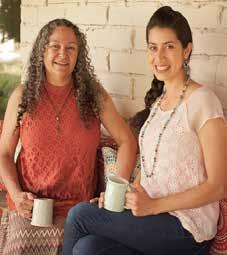
There are many reasons a woman would choose homebirth. One major reason that women choose homebirth so that the mother is free to exercise ownership of her body and birth. In a home setting, birth attendants act on your behalf with your permission and the woman has the ability to make decisions about their care – her choices are honored and respected. Knowledge of nutrition, hygiene, and a woman’s physiology have improved birth outcomespre and because of this and other factors, many families are moving toward homebirths.
Your pregnancy care provider works with you from the beginning of your pregnancy – it during this time that a meaningful relationship is created. The relationship carries over beyond birth through the postpartum period. Your care provider will understand and know what you are experiencing and will use her knowledge to take you through the entire pregnancy making sure that you are comfortable, safe, and successful.
The first criteria to examine when considering a homebirth is whether you would feel safe at home. This is key to feeling safe in pregnancy. The hormonal systems that are active during labor and birth unfold naturally when the mother feels comfortable in her surroundings. The next step is to find a homebirth provider – this is usually done by word of mouth. You must ask friends and family about their attendants, their feelings, and their experiences. You can also go online as there are many online groups that focus on the subject of homebirths. Let’s face it – the internet can inform and educate – read blogs, ‘mom and pregnancy’pages and information. Do check the California Association of Midwives – www. californiamidwives.org. Interview, ask about philosophy, care, experience, limitations – ask the questions that are meaningful, that will help you to make an informed decision.
Ideally you will have done this research early in your pregnancy (even before). The important thing is to start care ASAP so you can build a strong relationship. Homebirth is a personal decision, do your research and do it early.
Oh BABY! | 11
Nutrition: Eating for the Health of Your Family
FIRST TRIMESTER
In the first trimester of pregnancy by week 6, your baby has a beating heart, and by the 10th week of pregnancy you will have created all of the organs your child will have for the rest of their lives. During the first 13 weeks, it is common to feel nauseous, fatigued, and moody. Don’t worry, all those symptoms are perfectly normal, and you will not have to eat more now than if you weren’t pregnant. It’s often hard to eat in the first trimester because of nausea. Focus on small and frequent snacks/meals that are protein rich (nuts and seeds, legumes, dairy, and lean animal) and always pair a carbohydrate with a healthy fat or lean protein. It is easy to mistake nausea with hunger and thirst. Try adding lemon, lime, mint, or ginger to your water or hot tea. These are natural ways to manage nausea. Adding magnesium rich foods can help as well: pumpkin seeds, spinach, Swiss chard, and chocolate.
SECOND TRIMESTER
In the 2nd trimester your baby is laying down new bone. Bone building nutrients are a focus in the 2nd trimester. Most of us know the role that calcium plays in strong bones, but did you also know that bones rely on vitamins A, D, and K, as well as the minerals boron, molybdenum, manganese, and magnesium? Focus on colorful fruits and vegetables daily to consume all of these vitamins and minerals. The goal is at least 1 food from each color daily: blue/purple, red, orange, yel low, white/tan, and green. The easiest way to achieve this goal is to make a daily smoothie loaded with fruits and veggies. Spinach is the mildest green vegetable to hide in a smoothie. Try a couple big handfuls, you’ll never know it is there!
You’re pregnant! You’ve never had a better reason to eat healthy. A developing baby depends solely on the transfer of nutrients from the mother. These nutritional building blocks help maximize brain development, growth of all organs, and develop the integrity of your baby’s immune system The quality and the quantity of nutrition that you eat, the pollutants, drugs and infections that your body is exposed to during fetal develop ment, and the stress level and state of mind that you adopt while pregnant are all factors that shape your baby, your life, the lives of your grandchildren, and great-grandchildren. That’s right, not only can you grow a healthy child, but you can also optimize the health of your family for three generations. Balance in your lifestyle choices can bring vital health to your pregnancy.

THIRD TRIMESTER
Did you know that your baby’s brain grows by 260% in the 3rd trimester alone? Now that’s brain power! Focus on brain building nutrients in weeks 28-40 to help maximize cerebral development: protein, omega-3 fatty acids, zinc, iron, vitamin A, vitamin D, and B vitamins. All your healthy eating is starting to pay off. Even if you can’t see your baby eating, they are swallowing amniotic fluid daily and with it comes all the fla vors of the foods you have been eating. Recent studies show that you can influence the palette of your child starting in utero. By choosing foods that have strong and complex flavors such as herbs and spices, and colorful fruits and vegetables, you can prime your baby to enjoy diverse flavors before food introduction.
12 | Oh BABY!
TOP NUTRIENTS FOR PREGNANCY AND WHERE TO FIND THEM

Protein—promotes cell growth and blood production. Protein is a long-lasting fuel source for your body as your energy requirements are in high demand. Found in lean meat, fish, poul try, egg whites, legumes, nuts and seeds, tofu, and tempeh.
Carbohydrates—your body’s #1 fuel source. Found in whole grains, non-starchy and starchy vegetables, fruits, legumes, and dairy/dairy alternatives.
Fat—promotes healthy hair, skin, eye, nail, and membrane development and is a key part of your body’s energy stores. Found in olive oil, olives, avocado, coconut oil, sunflower oil, dark chocolate, nuts and seeds, seafood, and meat.
Vitamin A—an antioxidant and fat-soluble vitamin that helps create skin, eye, brain, and bone health, and fights off viral infections. Found in carrots, sweet potatoes, spinach, kale, bell peppers, parsley, Swiss chard, and collard greens.
Vitamin C—an antioxidant and water-soluble vitamin that works in harmony with iron in your body. Vitamin C is also a co-factor in the production of L-carnitine. Vitamin C helps with muscle cramps, constipation, and is the key in collagen—daily Vitamin C helps your stretching skin and decreases the risk of perineum tears at delivery. Found in red bell peppers, kiwi, strawberries, parsley, broccoli, and citrus.
Vitamin D—promotes a strong immune system, regulates insulin and blood sugar, lowers the risk of high blood pressure during pregnancy, reduces the risk of asthma and wheezing in your baby, increases the birth weight for your baby, and de creases the risk of postpartum depression. Found from the SUN! 20 minutes of a pinking dose of sunshine daily yields 20,000 IUs of vitamin D. Food sources include: egg yolks, sardines, cod, shrimp, and dairy products.
B Vitamins—B6, B12, and Folate—these water-soluble vitamins play their biggest role in cerebral development and decreasing the risk of neural tube defects. The neural tube opens and closes in the 1st 4 weeks of pregnancy. Taking B vitamins prior to conception is the best way to optimize cerebral health. B vitamins are energy producers, red blood cell formers, nervous system health regulators, mood improvers, and sleep givers. We like them. Found in nutritional yeast, bananas, pork, green leafy veggies, legumes, yellow fruits and veggies, whole grains, and nuts and seeds.
L-Carnitine—an amino acid that plays a crucial role in de creasing the risk of gestational diabetes. It is a big energy giver as well. Focus on this nutrient especially in the 2nd and 3rd trimesters. Found in red meat and pork, avocado, artichokes, asparagus, broccoli, Brussels sprouts, garlic, and parsley.
Calcium—strong bones and teeth, muscle contraction, and nerve function. Take calcium apart from iron as they bind in the body. Found in dark green leafy vegetables, rosemary, yogurt, kefir, milk, salmon, and sardines.
Iron—crucial for red blood cell production, healthy brain health and myelin sheath (fatty coating on all neurons) formation, and energy production. Found in lean red meat, spinach, pump kin seeds, kidney beans, tofu, Swiss chard, and edamame.
Zinc—a mineral that helps balance blood sugar, is an immune system regulator, supports optimal sense of taste and smell, is crucial in wound healing, and helps you make prolactin: the hor mone that helps you produce breastmilk. Found in crimini mush rooms, spinach, beef, lamb, summer squash, and calf’s liver.
Probiotics—friendly bacteria that colonize in your gut to help boost your immune system health. 80% of your immune system comes from your gut lining. Probiotics help protect you and your child from infection, improve digestion and absorption of nu trients, and decrease the risk of allergies in your child. Found in kefir, yogurt, kimchi (fermented vegetables), sauerkraut, tempeh and natto (fermented soy beans), and miso (soy paste).
Oh BABY! | 13
Identifying Warning Signs of Pregnancy Danger

For many pregnant women and expectant parents, the whole pregnancy phase is fraught with physical and emo tional changes. Pregnancy should be the time for women to be vigilant about their health. Pregnancy complications are not uncommon and while most problems may be rela tively mild and can be immediately treated, in other cases, warning signs can carry some significant health risks to the child, mother and possibly both.
Although it is generally advised for pregnant women to have frequent doctor visits, it is equally important to be aware of the possible danger signs to look for during pregnancy. These include the following signs:
Miscarriage
Bleeding during the first trimester can be a sign of pos sible miscarriage. According to statistics, about 20 percent of pregnancies end in miscarriage. These incidents usually occur when a woman is not aware that she is pregnant. Clots, bleeding and cramping are among the most com mon signs of miscarriage.
Ectopic Pregnancy
There are some cases the fertilized egg may not reach its correct position in the uterus and the embryo grows on the fallopian tube. Since it grows in an abnormal location, it causes tears in the blood vessels and delicate structures. It is known to display the following symptoms: lower back pains, nausea, lower abdominal pain, and cramping. This can require surgery to remove the non-viable embryo.
Premature Labor
One of the most common problems of pregnancy is premature labor and delivery. Babies born prematurely run the high risk of having respiratory problems and underde veloped lungs.
Hypertension
Elevated blood pressures are a common complication that occurs in 3 percent of pregnancies. It can cause some adverse effects on the placenta as well as the fetus. Severe elevation of blood pressure can cause pain in the abdo men, fluid retention, seeing spots, and headaches.
14 | Oh BABY!
•
•
•
•
•
•
•
•
•
•
•
• Vaginal bleeding
Sudden weight gain
Fever
Chills
Seeing spots
Persistent headache
Burning sensation when urinating
Vomiting
Blurred and/or double vision
Lower abdominal pain
Thigh pains • No baby movements for 12 hours • Premature cramping • Persistent lower back aches
Nausea
Risk Factors in Pregnancy
Although many pregnancies are considered normal and only need standard prenatal care from an Obstetrics & Gynecology (OB-GYN) provider, there are certain circumstances that may require you or your baby to have additional testing, monitoring and treatment. Maternal Fetal Medicine specialists have the expertise and services to help manage high-risk pregnancies.
Maternal Fetal Medicine specialists have advanced

• Heart or kidney disease
• Hypertension (high blood pressure) • Gestational Diabetes • Multiple-birth pregnancy • Seizure disorders
• Blood clotting disorders • Advanced maternal age • Preeclampsia (toxemia)
• Infectious diseases
• Repetitive pregnancy loss • Suspected abnormal fetal growth
In some cases, a pregnancy may be considered high risk if the mother has a family history of the following diseases: • Cardiac disease • Renal disease • Gastrointestinal disease • Cystic fibrosis
Maternal Fetal Medicine providers are experienced in a wide variety of complex high risk maternal fetal conditions and will partner with you to improve care for mom and baby/babies. By working with your OB-GYN provider, the specialist can help co-manage the high-risk pregnancy to ensure that you are closely monitored.
Maternal Fetal Medicine Services Include:
• Genetic counseling
• Pre-conception counseling
• First trimester screening
• Second trimester screening
• Evaluation of fetal anomalies and growth disorders
• Non-invasive prenatal testing
expertise in obstetric complications of pregnancy and their effects on the mother and baby. These providers are fully trained and qualified OB-GYN physicians who, upon completing a three-year fellowship, are certified as subspecialists by the American Board of Obstetrics and Gynecology (ABOG). This additional training allows the providers to care for women with issues deemed to be high risk to the mother or baby; including, but not limited to:
Some women with high-risk pregnancy symptoms may require a single consultation with a Maternal Fetal Medicine provider before or during pregnancy to help them prepare and to provide guidance to their obstetrician for managing their high-risk pregnancy. Other women may require ongoing specialist care throughout the pregnancy to help monitor the health of mother and baby by performing comprehensive fetal assessments with ultrasound and/or invasive evaluations. Following delivery, a Maternal Fetal Medicine specialist may be consulted to diagnose or manage postpartum symptoms related to the high-risk pregnancy. Ask your OBGYN provider about the Maternal Fetal Medicine specialists in your area.
Oh BABY! | 15
Your Pregnancy Month by Month
One Month
Your baby is an embryo consisting of two layers of cells from which all her organs and body parts will develop.
Two Months
Your baby is now about the size of a kidney bean and is constantly moving. He has distinct, slightly webbed fingers.
Three Months
By now your baby is about 3 inches long and weighs nearly an ounce. Her tiny, unique fingerprints are now in place.
Four Months
Your baby is now about 5 inches long and weighs 5 ounces. His skeleton is starting to harden from rubbery cartilage to bone.
Five Months
Eyebrows and eyelids are now in place. Your baby would now be more than 10 inches long if you stretched out her legs.
Six Months
Your baby weighs about a pound and a half. His wrinkled skin is starting to smooth out as he puts on baby fat.
Seven Months
By now, your baby weighs about 3 pounds and is more than 15 inches long. She can open and close her eyes and follow a light.
Eight Months
Your baby now weighs about 4 3/4 pounds. His layers of fat are filling him out, making him rounder, and his lungs are well developed.

Nine Months
The average baby is more than 19 inches long and weighs nearly 7 pounds now, but babies vary widely in size at this stage
16 | Oh BABY!
Fetal Development
The union of an egg and a sperm into a single cell, is the first step that leads to pregnancy. Fertilization takes place in the fallopian tube. Over the next days, the single cell divides into multiple cells. At the same time, the small clus ter of cells moves through the fallopian tube to the lining of the uterus. There it implants and starts to grow. From implantation until the end of the 8th week of pregnancy, it is called an embryo. From the 9th week of pregnancy until birth, it is called a fetus.
What happens during weeks 1–8 of pregnancy?
• Placenta begins to form.
• The brain and spinal cord begin to form.
• The tissues that will form the heart begin to beat. The heartbeat can be detected with ultrasound at about 6 weeks of pregnancy.
• Buds for limbs appear with paddle-like hands and feet.
• The eyes, ears, and nose begin to develop. Eyelids form, but remain closed.
• The genitals begin to develop.
• By the end of the eighth week, all major organs and body systems have begun to develop.
What happens during weeks 9–12 of pregnancy?
• Buds for future teeth appear.
• Fingers and toes start to form. Soft nails begin to form.
• Bones and muscles begin to grow.
• The intestines begin to form.
• The backbone is soft and can flex.
• The skin is thin and transparent.
• The hands are more developed than the feet.
• The arms are longer than the legs.
What happens during weeks 13–16 of pregnancy?
• Arms and legs can flex.
• External sex organs are formed.
• The outer ear begins to develop.
• The fetus can swallow and hear.
• The neck is formed.
• Kidneys are functioning and begin to produce urine.
What happens during weeks 17–20 of pregnancy?
• The sucking reflex develops. If the hand floats to the mouth, the fetus may suck his or her thumb.
• The skin is wrinkled, and the body is covered with a waxy coating (vernix) and fine hair (lanugo).
• The fetus is more active. You may be able to feel him or her move.
• The fetus sleeps and wakes regularly.
• Nails grow to the tips of the fingers.
• The gallbladder begins producing bile, which is need ed to digest nutrients.
• In female fetuses, the eggs have formed in the ovaries. In male fetuses, the testes have begun to descend.
• It may be possible to tell the sex of the fetus on an ultrasound exam.
What happens during weeks 21–24 of pregnancy?
• The fetus may hiccup.
• The brain is rapidly developing.
• Tear ducts are developing.
• Finger and toe prints can be seen.
• The lungs are fully formed but not yet ready to function outside of the uterus.
What happens during weeks 25–28 of pregnancy?
• The eyes can open and close and sense changes in light.
• The fetus kicks and stretches.
• The fetus can make grasping motions and responds to sound.
• Lung cells begin to make a substance that will enable breathing.
What happens during weeks 29–32 of pregnancy?
• With its major development finished, the fetus gains weight very quickly.
• Bones harden, but the skull remains soft and flexible for delivery.
• The different regions of the brain continue to form.
• Hair on the head starts to grow.
• Lanugo begins to disappear.
What happens during weeks 33–36 of pregnancy?
• The fetus usually turns into a head-down position for birth.
• The brain continues to develop.
• The skin is less wrinkled.
• The lungs are maturing and getting ready to function outside of the uterus.
• Sleeping patterns develop.
What happens during weeks 37–40 of pregnancy?
• The fetus drops lower into the pelvis.
• More fat accumulates, especially around the elbows, knees, and shoulders.
• The fetus gains about half a pound per week during this last month of pregnancy.
Oh BABY! | 17
Ultrasound/Sonograms: An essential part of Prenatal Care
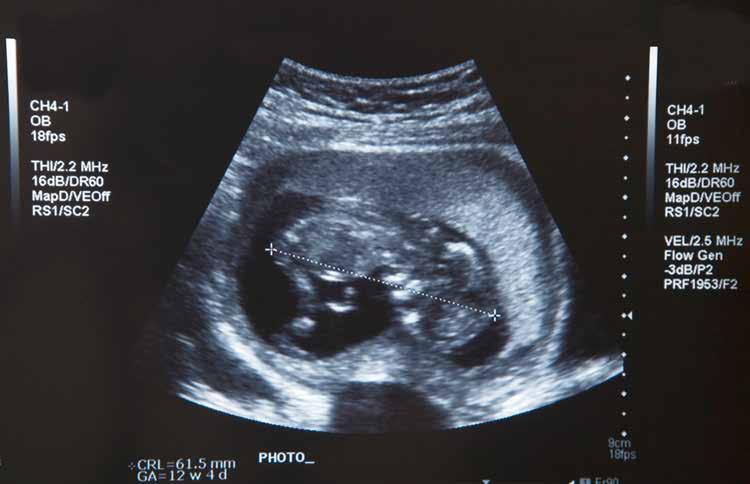
For many Moms-to-be, a first ultrasound is a life-changing experience. As a medical procedure, it is one that patients look forward to.
A fetal ultrasound or sonogram is an imaging technique that uses high-frequency sound waves to produce images of a baby in the uterus. An ultrasound can help your doctor evaluate your baby’s growth and development as well as gauge the progress of your pregnancy.
Your first ultrasound will typically be done between 18 and 20 weeks, but you may have one before 12 weeks to confirm your due date. You may also have an earlier ultrasound — or more than one — if yours is a high-risk pregnancy, if you have any pain or bleeding, if you have a history of having children with birth defects, or if another prenatal test or exam shows something abnormal. In addition, you’ll have additional ultrasounds if you have a chronic illness such as diabetes or a history of ovarian cysts or fibroids.
A first trimester ultrasound exam is done to evaluate the presence, size, and location of your pregnancy. It also helps your doctor to evaluate any problems, screen for abnormalities, or confirm a diagnosis. If your baby’s health needs to be monitored more closely, additional ultrasounds will be recommended.
What happens during an ultrasound? After you lay down on the
exam table, a small amount of gel is applied to the skin of your abdomen. A device called a transducer is applied to your skin, sending high-frequency sound waves into your body that reflect off the internal structures. The echoes are received by the transducer and turned into a picture on the screen.
All fetuses are approximately the same size in the early weeks of pregnancy, so a sonogram allows your doctor to approximate your due date. If you have your sonogram between 7 and 13 weeks, your doctor can set your due date within about 3 days!
A mid-pregnancy ultrasound is done at around 20 weeks. This sonogram is also called the anatomy scan. Your doctor will listen to the baby’s heartbeat, check for physical abnormalities, check the organs, determine if there’s more than one baby (twins!), measure the amount of amniotic fluid, check the location of the placenta, and measure your baby to be sure he or she is the right size for his or her gestational age. And yes – determine the sex of your baby… This is the exam where you can catch a glimpse of your baby – and go home with a picture or two!
When properly done, an abdominal ultrasound poses no risk to you or your baby. In fact, there are many benefits to checking on your baby’s development during pregnancy. It is generally advised that an ultrasound be performed only if medically indicated.
18 | Oh BABY!
Pregnancy Milestones
Record these important milestones, along with your emotions at the time. They’ll make terrific entries in your little one’s book!
First time I heard my baby’s heartbeat:
First time it really sank in that I was going to be a mom:
First time a stranger asked me if I was pregnant:
First time I experienced morning sickness:
First time I bought a new-baby outfit:
First time I wore a maternity dress:
First time I couldn’t button my pants:
First time my parents found out I was having a baby:
First time I saw my baby on an ultrasound:
First time I could not longer see my feet:
First time I felt my baby hiccup:
First time I felt the baby kick:
Oh BABY! | 19
Pregnancy Visits
Date: The week of my pregnancy: Weight: Weight gained since the start of my pregnancy: Blood pressure: Fundal height: Baby’s heart rate: Other tests: Prescribed medications: What I can expect before my next prenatal visit: Instructions from my doctor: How much weight should I gain: Notes:
Date: The week of my pregnancy:
Weight: Weight gained since the start of my pregnancy: Blood pressure: Fundal height: Baby’s heart rate: Other tests:
Prescribed medications: What I can expect before my next prenatal visit: Instructions from my doctor: How much weight should I gain: Notes:
20 | Oh BABY!
Pregnancy Visits
Date:
The week of my pregnancy:
Weight: Weight gained since the start of my pregnancy: Blood pressure: Fundal height: Baby’s heart rate: Other tests: Prescribed medications: What I can expect before my next prenatal visit: Instructions from my doctor: How much weight should I gain: Notes:
Date:
The week of my pregnancy:
Weight: Weight gained since the start of my pregnancy: Blood pressure: Fundal height: Baby’s heart rate: Other tests:
Prescribed medications: What I can expect before my next prenatal visit: Instructions from my doctor: How much weight should I gain: Notes:
Oh BABY! | 21
Pregnancy Visits
Date: The week of my pregnancy: Weight: Weight gained since the start of my pregnancy: Blood pressure: Fundal height: Baby’s heart rate: Other tests: Prescribed medications: What I can expect before my next prenatal visit: Instructions from my doctor: How much weight should I gain: Notes:
Date: The week of my pregnancy:
Weight: Weight gained since the start of my pregnancy: Blood pressure: Fundal height: Baby’s heart rate: Other tests:
Prescribed medications: What I can expect before my next prenatal visit: Instructions from my doctor: How much weight should I gain: Notes:
22 | Oh BABY!
Pregnancy Visits
Date:
The week of my pregnancy:
Weight: Weight gained since the start of my pregnancy: Blood pressure: Fundal height: Baby’s heart rate: Other tests: Prescribed medications: What I can expect before my next prenatal visit: Instructions from my doctor: How much weight should I gain: Notes:
Date:
The week of my pregnancy:
Weight: Weight gained since the start of my pregnancy: Blood pressure: Fundal height: Baby’s heart rate: Other tests:
Prescribed medications: What I can expect before my next prenatal visit: Instructions from my doctor: How much weight should I gain: Notes:
Oh BABY! | 23
Pregnancy Visits
Date: The week of my pregnancy: Weight: Weight gained since the start of my pregnancy: Blood pressure: Fundal height: Baby’s heart rate: Other tests: Prescribed medications: What I can expect before my next prenatal visit: Instructions from my doctor: How much weight should I gain: Notes:
Date: The week of my pregnancy:
Weight: Weight gained since the start of my pregnancy: Blood pressure: Fundal height: Baby’s heart rate: Other tests:
Prescribed medications: What I can expect before my next prenatal visit: Instructions from my doctor: How much weight should I gain: Notes:
24 | Oh BABY!
Pregnancy Visits
Date:
The week of my pregnancy:
Weight: Weight gained since the start of my pregnancy: Blood pressure: Fundal height: Baby’s heart rate: Other tests: Prescribed medications: What I can expect before my next prenatal visit: Instructions from my doctor: How much weight should I gain: Notes:
Date:
The week of my pregnancy:
Weight: Weight gained since the start of my pregnancy: Blood pressure: Fundal height: Baby’s heart rate: Other tests:
Prescribed medications: What I can expect before my next prenatal visit: Instructions from my doctor: How much weight should I gain: Notes:
Oh BABY! | 25
Pregnancy Visits
Date:
The week of my pregnancy:
Weight: Weight gained since the start of my pregnancy: Blood pressure: Fundal height: Baby’s heart rate: Other tests:
Prescribed medications: What I can expect before my next prenatal visit: Instructions from my doctor: How much weight should I gain: Notes:

26 | Oh BABY!
Exercising during Pregnancy helps keep you Healthy
Exercise During Pregnancy - Myth Broken
It is a myth that exercis ing during pregnancy can be harmful to the unborn as well as the mother. In fact, exercising during pregnancy is beneficial for both the mother and the child. It reduces physical discomfort, and also reduces stress and labor length. Here’s a list of frequently asked questions with answers about exercise during pregnancy:
Is it safe to do workouts during pregnancy?
Working out during preg nancy is not only safe, but healthy if you do not have any complications during the pregnancy period. It is recommended that you consult your doctor or midwives and get their approval.

Why is exercise necessary during pregnancy?
Research tells us that working out or mild exercise during pregnancy helps in reducing backaches, swelling of ankles, and constipation - some of the most common problems faced by pregnant women. In addition, exercise gives you energy and makes you feel fresh.
Does exercise help during pregnancy?
The answer is ‘Yes’. Exercising during pregnancy pro motes muscles, strength, and endurance, thereby, helping the mother to carry the additional weight gained during pregnancy.
I do a rigorous workout. Is it safe during pregnancy?
According to a study in the American Journal of Ob stetrics and Gynecology, healthy, well-conditioned women who exercised before pregnancy may continue to do so throughout their pregnancy without compromising their baby’s health or development. Be particularly careful dur ing the first trimester – don’t overdo.
For how long should I exercise?
The workout should be approximately 45 minutes long and should include a warm-up, the workout, and a cool down.
What precautions do I need to take while exercising during pregnancy, if I have never worked out before?
Talk to your doctor or midwife. As long as you have permission to proceed, you can engage yourself in mild exercise, like walking or swimming.
Immediately after the birth of my child, what exercises can I do to regain my shape?
Make sure you are physically ready before you start with the process of regaining your shape. Once you think you are fit to start with an exercise regimen, begin with stretching and firming exercises, gradually add a second set of exercises.
Just remember that you need to follow normal exer cise safety like, drinking lots of water, stopping immediate ly if you feel any pain etc. Most importantly, remember to speak to your doctor before starting any exercise regimen.
Oh BABY! | 27
Showing off that Bump!
Pregnancy may change your figure, but the pounds you gain give you a different kind of beauty. It’s important to maintain your style – you’re still you – you’re just pregnant – it’s time to show off that baby bump! Yes, show off the bump in style!

#1 – Get the basics – a couple of pair of jeans that fit with your lifestyle — skinny, boyfriend, bootcut, jeggings – today’s pregnancy jeans are made by designers and that pregnancy panel comes in many cuts and sizes.
#2 – Get a couple of stretchy lycra dresses –yes, clinging lycra to show off your baby bump. This type of dress will carry you through any special occasion.
#3 – Get a few maxi dresses – these dresses go casual, can be paired with a cardigan, sandals, boots, or flats – they dress up and they dress down.
#4 – Get some workout wear for your growing belly. You’ll find that athleisure-wear goes from day to night with the change of a top…all while keeping you
comfortable and in shape (yes, you can workout during pregnancy).
#5 – Get some jackets and cardigans – these will change your look from casual to dressy and look great with dresses, skirts, and leggings (not to mention, those jeans).
#6 – Get regular clothing in a size or two larger than your normal size…this way you stay true to your style.
#7 – Tanks and tees – these will be your lifesavers… pair with your jeans or leggings and a cardigan and you look pulled together.
#8 – Accessorize – scarves, jewelry, and shoes are important. They can also add a touch of color and style to an outfit.
Whatever your style, stay with it, be comfortable, be YOU!
28 | Oh BABY!
Placenta
Encapsulation
The placenta is your body’s temporary organ that delivers nutrients, oxygen, and blood to the baby during pregnancy and it removes waste from the mother – it is your baby’s lifeline. The placenta surrounds the fetus in the womb. Placenta encapsulation has been around for centuries, mainly in Eastern medicine, but it is a practice that has been gaining popularity in the US in recent years.
Placenta encapsulation is the practice of ingesting the placenta after it has been dehydrated and made into pills.
It is believed that by ingesting your placenta after birth, you can avoid postpartum depression, mood swings, improve both milk and iron supply, and increase the release of oxytocin (helping the uterus to return to normal size) – all positive things.

Some celebrities have posted on social media that they are encapsulating their placenta and it has given this ancient practice renewed life and popularity. While there is little scientific research, there are those who believe that the advantages include:
• Increased release of the hormone oxytocin – helps the uterus return to normal size
• Increase in CRH – stress reducer

• Decrease in postpartum depression
• Increases the Mom’s energy levels
• Restores iron levels in the blood
• Increases milk production
Your doctor or midwife should know well in advance that you wish to take your placenta with you (after birth). You want to be certain that the placenta is handled properly – safely. You must treat your placenta as you would any other meat product – it must be refrigerated and treated like that steak in the freezer. With encapsulation, your placenta is taken, cleaned, dehydrated, and ground into a coarse powder – it is then made into small pills or capsules that look just like the vitamins you may be already taking. Over the next weeks, the mother takes a pill each day.
Oh BABY! | 29
30 | Oh BABY! Here are
girls
baby
Popular Baby Names for 2019 1 2 3 4 5 6 7 8 9 10 11 12 13 14 15 16 17 18 19 20 21 22 23 24 25 26 27 28 29 30 31 32 33 34 35 36 37 38 39 40 41 42 43 44 45 46 47 48 49 50 Liam Noah Oliver Mason Lucas Elijah Logan Ethan James Aiden Carter Jackson Sebastian Alexander Benjamin Jacob Michael William Daniel Grayson Jack Leo Luke Henry Jayden Wyatt Owen Julian Gabriel Jaxon David Levi Matthew Mateo Muhammad Asher Josiah John Lincoln Adam Ryan Nathan Samuel Isaac Joseph Caleb Isaiah Eli Anthony Hunter 1 2 3 4 5 6 7 8 9 10 11 12 13 14 15 16 17 18 19 20 21 22 23 24 25 26 27 28 29 30 31 32 33 34 35 36 37 38 39 40 41 42 43 44 45 46 47 48 49 50 Emma Olivia Ava Isabella Sophie Amelia Mia Charlotte Harper Mila Aria Avery Ella Evelyn Lina Sofia Abigail Layla Riley Scarlett Ellie Emily Lily Chloe Madison Zoey Camila Penelope Elizabeth Victoria Grace Nora Bella Aubrey Hannah Aurora Stella Addison Skylar Maya Hazel Natalie Savannah Paisley Nova Violet Emilia Elena Brooklyn Niamey
the year’s most popular baby names for
and boys. These
name lists base popularity ranking on a single spelling of a name (Sophia and Sofia, for example, are considered two different names).
Choosing the Right Child Care

While you would love to stay at home with your child, of ten it’s just not financially feasible. You’ll have to find the right child care. Where do you start? Instinct counts for much…but you have to visit the site to make sure the facility will support and enrich the development of your child physically, emo tionally, socially and cognitively. Here’s a very important list that will guide you in your choice.
Will My Child Be Supervised?
Are children watched at all times, even when napping? Are the teachers warm and welcoming? Do they pay each child individual attention? Are positive guidance techniques used? Are the staff-to-child ratios appropriate and do they follow guidelines set by the Department of Human Services (one caregiver per 4 infants/toddlers; one caregiver per 6 two year olds; one caregiver per 8 three year olds; one caregiver per 12 four year olds; and one caregiver per 15 school-age children).
Is This A Safe And Healthy Place For My Child?
Do the teachers and children wash their hands (before/ after eating, using the bathroom, changing diapers, touch ing bodily fluids, etc)? Are surfaces sanitized after each use? Are all children immunized? Are medicines labeled and kept out of children’s reach? Are the foods and beverages served to the children healthy and nutritious? Are cleaning supplies and other hazardous materials stored out of children’s reach? Is there a plan to follow if a child is injured, sick, or lost? Are first aid kits readily available? Is there a plan to respond to disasters? Has a thorough criminal and background check been done on all teachers? Is the outdoor play area safe for children to play and is it inspected daily for hazards and regularly for condition? Is the play are fenced in? Is the equipment on mulch, sand or rubber matting?
Have The Adults Been Trained To Care For Children?
Does the Director have a degree and experi ence caring for children? Do the lead teachers have a Child Development Associate (CDA) credential, Associate’s, or Bachelor’s degree and experience in caring for children? Is there always someone present who has current CPR and First Aid Training? Have the teachers
been trained on child abuse prevention and how to report a suspected case? Have the teachers received blood borne pathogens and disease prevention training? Is there ongoing education and training on the care of children?
Will My Child Be Able to Grow And Learn?
Are the toys age and developmentally appropriate? Are there a variety of toys? Is the room arranged in easily identifi able play centers? Are there daily/weekly lesson plans? Do the teachers talk, converse, and question the children? Do the teachers read to the children often and are books readily available?
Is The Program Set Up To Promote Quality?
Are there written personnel policies and procedures? Are the parents and staff asked to evaluate the program? Are teachers evaluated each year – do they do self assessment? Is the program accredited by a national organization?
Does The Program Work With Parents?
Will I be welcome to visit the center any time my child is in their care? Is parent’s feedback sought and used in making improvements? Will I receive access to policies and proce dures? Are there yearly conferences with parents? Are there any special parent events?
Oh BABY! | 31
Budgeting for Baby… Now and in the Future

expense for your baby. Take time to research your options. Child care facilities offer many options, levels of care, hours, food, classes, and other benefits and options –things you want to know when considering who cares for your child. Which facility or caretaker best fits your budget and lifestyle? Where do you feel your baby will feel safe and comfortable?
Start Planning for the Future
Once your baby’s social security number is in your hand, look in to special savings accounts for college. Encourage family and friends to make contributions to this fund in lieu of toys for special occasions. Parents do just fine showering their children with toys and love…so make each special occasion a time to prepare for the future and contribute to this very important fund.
Prepare a Will
A new baby brings big financial changes and budget ing challenges…What does a baby cost? How do I plan financially for the arrival of my baby? What expenses will I incur before and after my child arrives? What plans should I be making to secure the future of my child? So many questions and concerns…and while some expenses are obvious – if you’re budgeting for baby, you have to plan for the unexpected.
Government estimates suggest that you’ll spend about $10,000 on child-related expenses in the first 2 years of life. It is important to break down the one-time expenses – décor, equipment, gear; the monthly expenses – medi cal, food, clothing, toys, child care; and those unexpected expenses – life insurance, education savings.
Plan for Medical Expenses
Did you know you’re already financially planning for your little one’s arrival? You are making financial arrange ments with your doctor and the hospital as you progress through your pregnancy. It will be important for you to contact your insurer to see what additional medical expenses you could incur in case of complications. You’ll need to have your child on a health plan by the time he or she is 30 days old. Talk to the professionals – get the best coverage for your child and your family.
Find Child Care
Child care expenses can easily be the largest monthly
A will is a financial responsibility you have to your new family member. If something should happen to you, it is important to decide who will step in as their legal guard ian. Who will protect them financially? If for no other rea son – taking care of your child or children requires that you have a will. Without a will, you have no say as to how your assets are distributed after your death. Use a professional, ask questions, execute a will that covers every concern. Should you have life changes – more children, adoption, marriage or remarriage, change of executor, moving to another state with different laws – update the will.
Plan for the Unexpected - Life Insurance
You have big plans for your kids and want to see them realize their hopes and dreams. It’s hard enough to make that happen the way it is. But what if you, your spouse, or both of you were to suddenly be out of the picture? From diapers to diplomas, would there be enough income to pay for day care, education, and everything in between? Your children are your greatest responsibility, and life insurance can help them grow up in an environment where they’re physically and financially secure – even if some thing should happen to you. In addition to coverage for mom and dad, protection for your child is also important. The benefit for children’s coverage includes providing a solid financial basis early in life, protection, and final expense coverage should the unthinkable happen. Simply put, let life insurance be a part of creating a bright future.
32 | Oh BABY!
Baby Nursery Design in 12 Easy Steps

Decorating a baby nursery can be a daunting prospect – especially for a first-time mom. There are so many decisions to make, and so little time…feeling stressed? Well that’s not good for the baby, so let us give you the basics for creating a haven for your little one… one step at a time…
Step 1: Baby safety is your first concern. Be sure to take this into account as you design your baby’s abode. Use a checklist for baby safety and plan accordingly.
Step 2: Decide on a room style. Cute, modern, traditional,
whimsical, ethnic, the choice is yours. This decision will affect your furniture, theme, and color choices.
Step 3: Select a crib. The crib will form the focal point or centerpiece of your baby’s room. Consider a convertible crib as this will save you money over time and will grow with the child (and everything will continue to match for years to come). When selecting, look for shape, style, finish or color, durability – do you like it? Very important.
Step 4: Find baby nursery furniture to complement the crib. The dresser should match or mix well with the crib.
Oh BABY! | 33
Baby Nursery Design in 12 Easy Steps
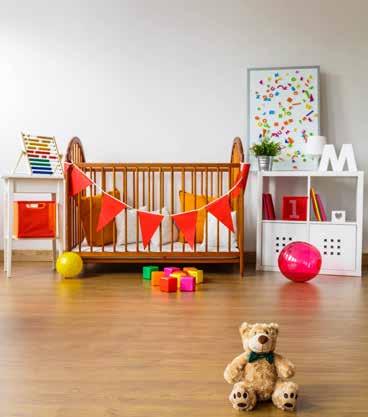
The dresser can do double duty as the changing table (add a pad and safety straps and you’re set). Having said that – you can also get a changing table. If you use the dresser as the changing table, get one that is medium height – that allows you to lean over comfortably for needed supplies. The top drawer will hold all of your diaper-changing essentials – make sure the drawer is easy to get in and out of – it should glide/slide easily.
Step 5: Lighting is essential – and must be flexible. Sometimes you’ll want it bright and sometimes soft. You want to be sure your night lighting allows you to see in the middle of the night (but not so it stimulates the baby). Consider a dimmer switch for your lighting.
Step 6: If you already have wall to wall carpet in the room – that’s fine – you’re not likely to make the change (or go to the expense) – just be aware that you need to keep it vacuumed to avoid allergens (and be prepared to spot clean – it’s inevitable). Other flooring options are
hardwood, laminates, concrete – with the addition of a nice area rug or rug tiles. You can decorate a room around a rug – it can anchor your décor.
Step 7: After you’ve gotten the basics decided upon, it’s time to decorate the room. Do you have a theme? Is it about heirlooms? Colors? Style? Read decorating magazines, check out Pinterest, go shopping – you’ll see things you like and can build your baby’s room to perfection.
Step 8: The color you choose for the walls will be influenced by your ‘theme’. The things you can do with paint are amazing – stripes, murals, stencils, multi-colored walls – the background to your decorating vision.
Step 9: Now the accessories are added to your vision… pictures, art, lamps, bedding, wall hangings, storage, fabrics – as you go through the process, shop for things that please your eye. BUT, stay with your vision – see it through to perfection. You will get sidetracked along the way – just look for the items that go with what you have, that fulfill the look, and that are pleasing to the eye. This is the room your child will grow up in and it is a room you want to be happy with too.
Step 10: Curtains, blinds, shades – stay with the vision. Also make sure that you can block light when needed. Make sure the crib is not near these things as children tend to climb and are attracted to anything within reach (keep any and all cords away from the baby).
Step 11: Equipment – you’ll need a few extras: a baby monitor, a mobile, safety gates, high chair, stroller, travel crib, diaper bags, playpen, white noise machine, humidifier, diaper pail, a car seat, a baby carrier, a rocker or glider, shelves and bins for toys, outlet covers. That’s a good start.
Step 12: You’re done. Now relax and wait for your baby to come and change your life forever.
34 | Oh BABY!
Nesting and a Safe Environment
Once you bring your new baby home, the last thing you’ll want to do is go shopping or head out to get items you’ve forgotten to have on hand during those first days, weeks, and months. If you plan in advance, those first days and weeks with your baby can run much smoother because you’ve thought of almost ev erything and you’ve taken the time to get organized. Nesting hits the hardest between your sixth and eighth month of pregnancy…you know the gender of your child, you’ve started planning and dreaming of life with your little one, you’ve been decorating their en vironment, and you want everything perfect – perfect and safe. During the last month of your pregnancy, you’re too uncomfortable or too tired to do much but wait for your child’s arrival. Below is a list of things to do before your baby arrives.
NESTING – THINGS TO DO BEFORE YOUR BABY COMES HOME:
• Plan a budget for the time you won’t be working (if you work outside the home);
• Set a schedule for bill payment – consult with your partner if you are the bill payer;
• Clean everything in your home – carpets, fans, baseboards, windows, draperies/curtains;




• Have your home exterminated – there are safe and organic methods of extermination that will not harm your family (and baby);




• Wash all of your baby’s clothing and linens;
• Make freezer meals and dinners in advance for the first few weeks of recovery and bringing your baby home;
• Have select meats frozen so you and your partner can easily grill or cook in the oven;
• Buy pantry staples;
• Clean out the refrigerator and restock with new condiments;
• If you order in meals – have those delivery numbers handy;
• If you want to make it really easy – get paper plates and plastic silverware;
• Stock up on toiletries (soap, shampoo, toothpaste, etc.);
• Clean out the car and have it detailed;
• Put the baby’s car seat in the car – check to make sure it is absolutely installed correctly;
• Organize anything an older sibling will need while you are in the hospital and the weeks right after your baby comes home.
Oh BABY! | 35
CPR –Cardio Pulmonary Resuscitation
As if you’ve got nothing else on your mind with your new baby…here’s one more thing that is very very important to know and that’s CPR – Cardio Pulmonary Resuscitation. It’s daunting to even think you might have to actually use CPR on your child, but your best chance for success in an emer gency is knowing how to correctly perform CPR.
There are many injuries that can cause a person to stop breathing. In children, injuries could include, choking, neardrowning, asthma, head trauma, poisoning, smoke inhala tion, electrocution, suffocation, apnea obstruction, and sudden infant death syndrome among other possibilities. Statistically, children are more prone to accidents than their parents (as if you need another reason).
CPR restores the flow of blood to the brain, heart, and other vital organs. Without oxygen-rich blood flowing to these or gans, damage and even death can occur. Performing CPR can restore breathing until advanced care and life support can be administered.
Ideally, you’ll take this course before you have your child (but if not, do it shortly after). You’ll go to a class with a certified instructor. In an infant CPR class, you’ll learn how to prevent, recognize, and respond to breathing emergencies. Your instructor will use an infant-sized mannequin to dem onstrate how to perform CPR, and will guide you through the proper techniques. In many classes your instructor will advise on accident prevention and childproofing your home – accidents can be prevented.
CPR for an infant is different from CPR for adults. You use your fingers to do chest compressions (as opposed to your hands). A child’s smaller and more fragile body requires less pressure when performing the compressions. There are 3 basic parts to CPR: Circulation, Airway, and Breathing with compressions being the most impor tant. Call 911 immediately and let them know of your emergency – if someone is with you and has a phone, have them make the call while you begin to administer CPR. Get the patient on a flat surface on their back:
• Check for normal breathing by looking for the rise and fall of the chest.
• Ensure that the airway is open; it could be food or an other object blocking the airway. Open the airway to enable CPR;
• If there is not normal breathing, you will start chest
compressions - 30 chest compressions; followed by 2 breaths; this cycle will continue. To give breaths, open the airway using a head-tilt chin-lift.
• Check the child’s carotid artery for pulse by placing 2 fingertips and applying slight pressure on the artery for 5 to 10 seconds. The carotid artery is located in the de pression between the windpipe and the neck muscles. You should also check the infants pulse on the brachial artery (inside of the arm between the elbow and shoul der).
Remember – You may be your child’s only chance of sur vival. Early recognition, getting help there ASAP, and early bystander CPR can double and even triple the chances of survival.
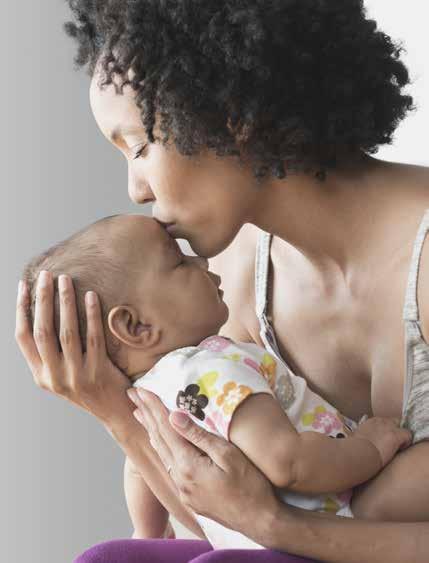
36 | Oh BABY!
Car Seats...
Get there safely in the right car seat
Your baby will soon be going places! The most important thing to know about car seats is that your child should be in a rear-facing car seat until the age of 2.
There are three types of rear-facing car seats. Each will work for a child less than 2 years of age who still meets the weight and height limits.
Rear-Facing Only Seat. People often buy this type of seat because it is portable. Most, but not all, can be used in strollers that are sold with the car seat or those recommended by the manufacturer. Caregivers can also purchase extra bases for the car seat so that it can be used in several cars.
Convertible Car Seat. This seat is larger and stays in the car. It can be used rear facing until your child is at least 2. After that, it can change to a forward-facing seat.
3-in-1 car seat. This seat also stays in the car. You can use it rear facing, forward facing, and then later, as a booster seat.
Of course you want to turn your baby around – you want her to see the same big world that you see when traveling together as a family. Just know that children grow up really fast and keeping your baby safe is the most important thing. Here are a few tips to help you through the time and transition: Don’t be in a hurry! The safest car seat for children under the age of 2 is a rearfacing seat. The new SC State Law requires a rearfacing seat until the child is 2 years of age. Riding in a rear-facing car seat will help protect your child’s head,
neck and spine in a crash. Kids grow a lot during the first two years, so you may have to move your child from a smaller rear-facing-only car seat to a bigger convertible car seat or a 3-in-1 car seat installed in the rear-facing position. Check the label. Your child will be ready for a larger, rear-facing car seat when she passes the weight or height limit on the car seat label or when her head is within one inch of the top of the car seat.
Long legs? Older children with longer legs can stay in a rear-facing car seat as long as they comfortably cross their legs. All children, even those with special healthcare needs, follow the same rules for staying safe in the car.

Oh BABY! | 37

Safety and Baby-Proofing Your home

Preventing Baby Burns – Don’t hold hot liquids when holding your baby. Do not microwave the baby’s bottle –microwaves heat unevenly and can burn the baby’s mouth. Warm the bottle in a bowl of warm water – shake the bottle – test the temperature.
Preventing Accidents – Keep sharp objects in secure places – out of baby’s reach. Don’t shake or throw the baby in the air (blindness and brain damage can occur). Secure lamps that have cords to the baseboards (try using electrical tape along the baseboards). Keep cleaning items and drugs out of your child’s reach.
Your child’s safety is an important responsibility – your responsibility. The tips below should help you to keep your baby safe and out of harm’s way. For the first 2 months, don’t take your baby to large public places such as malls and grocery stores – avoid crowds (germs). Keep your well-baby doctor appointments as it is important to check your baby’s developmental milestones.
Smoking and Fire Safety – Do not smoke or allow smok ing around your baby. Install a working smoke alarm on every level of your home. Change the batteries on your smoke de tector every 6 months. Have at least one fire extinguisher on every level of your home. If your home uses gas heat, install a carbon monoxide detector.
Safety in the Car – Always use a federally approved car seat. Read the instructions for installation. Car seats should face the rear of the vehicle for the for the first 2 years of the baby’s life. The safest location for the seat is the middle of the back seat. Never put the baby in the front seat or on your lap. Disengage the air bag if you are in a truck with no back seat. Leave your purse, briefcase, or cell phone in the back seat to avoid accidentally leaving the child in the car – this will get you in the habit of looking in the back seat.
Preventing Falls – If you use an infant carrier, always place it on the floor – not on a counter or table – and make sure the baby is strapped in. Never leave the baby alone on a couch, changing table, or bed.
Bath Safety – Start bathing after the cord falls off using soap for sensitive skin. Always test the water to make sure it is not too hot (before setting your baby in the water). Dipping your elbow in the water is a good way to test. It’s a good idea to turn the hot water heater to 120 degrees F. Never leave the baby unattended or with a sibling – it only takes seconds for a baby to drown. Bathroom appliances (hair dryer, curling iron, radio) should be away from the water/tub. Make sure these appliances are unplugged when not in use.
Toy Safety – Inspect toys regularly for breaks, sharp edges, small parts – toys should be larger than your baby’s mouth. Toy chests need to be open (no lids) or with supports that keep it open in any position.
Choking/Strangulation – Keep cords away from the baby’s crib – secure cords on blinds. Make sure clothing with but tons are secure and tight (the buttons). Don’t use baby items that have strings or cords. Put away small objects that can cause choking.
Safe Sleeping – The baby should have a separate sleep ing space (crib, bassinette, or cradle). A firm mattress with a tight fitting sheet is best. No bumper pad, pillows, or fluffy blankets in the crib. Crib is away from cords/blinds/electric outlets. Place your baby on his or her back for the first 4 months – no pillows. A one-piece sleeper is a good choice for sleeping. Don’t share a bed with your baby.
More Tips – Take a CPR class. Gather a list of emergency numbers and keep them by the phone (or in your mobile) – pediatrician, health care provider, family doctor, police department, fire department, and poison control. Have a will and name a guardian for your child in the event something should happen to you and your husband.
Oh BABY! | 39
Choosing a Pediatrician
If you already have a family doctor, you may not think you need a pediatrician. Although a general physician is licensed to care for children, they lack the training of a pediatrician. To become a pediatrician, a doctor has to have four years of medical school and three more years of residency working solely in pediatrics. Some are further specialized in a field like neonatalogy or cardiology.
You should start looking for a pediatrician in the seventh month of pregnancy. Start compiling the list by asking family and friends if they have any recommendations. Check with your insurance company for eligible pediatricians and with your local hospitals to see if they have referral services. Ask your obstetrician or family doctor if they know of someone. Research.

Ask yourself if you want a male or female doctor. There may be a point when your child gets older that they will feel more comfortable with a doctor of the same sex. Do you want an older or younger doctor? An older doctor will have more experience, but could be set in their ways and not open to new technology or methods. They might be thinking about retirement. A younger doctor, on the other hand, may be more open to new technology or methods, but lack the experience of an older doctor. Like choosing an obstetrician, do the work – find out what fits you and your lifestyle.
You’ve narrowed your list of choices, now comes some
investigative work. Before interviewing a pediatrician, check with the state medical board to see if any disciplinary action or professional peer reviews have been made against the pediatrician. Check out the books put out by the Director of Public Citizen’s Health Research Group. These list doctors who have been disciplined by a state or federal government.
As you interview the candidates on your list, look for a pediatrician who is open-minded and compassionate to your feelings and thoughts. Make sure the pediatrician is covered by your insurance and will actually be seeing your child. Most pediatricians will do these interviews for free, but some will charge. If they charge, see if the fee can be applied to the first office visit. If a pediatrician won’t do an interview, be wary of them.
Once you have made your choice, there are no hard and fast rules that say you have to stick with it. If you ever become concerned with your child’s care, discuss the situation with the pediatrician. If the problem continues, find a new pediatrician.
Choosing a pediatrician for your child may be the single-most important decision you make for their young years. Unfortunately, most people don’t spend enough time doing so. Next to parents, a pediatrician is one of the most important people in a child’s life, so choose wisely.
40 | Oh BABY!






Oh BABY! | 41
Common Questions to Ask Your Pediatrician
Before going in for the interview, check out the office. Is it clean and organized?
Are there separate waiting rooms for sick and healthy?
Is the staff courteous?
Do they listen to parents’ concerns?
What are the office hours?
Is there a lab on site? What doctor is recommended for work not done on site?
Do they do eye and hearing checks in the office?
How easy is it to get through on the telephone?
Is the practice large or small?
Is there more than one office?
How much time is spent at each office?
When you interview the pediatrician, ask them about their educational background.
How long have they been in practice? Are they board certified?
How do they stay current on the latest medical developments?
Can they be reached with questions, either routine or emergency?
Do they have specific call-in times?
Do they have a Website that will allow you to reach them by email?
In the event your child becomes ill, when would they refer your child to the emergency room?
What hospital do they use? Who covers when they are away?
Are there resident physicians, nurse practitioners, medical students and nurses on staff?
How involved will they be in caring for your child?
What kind of time will they spend with your child at a typical visit?
When do they prescribe medication? What kind of medication do they regularly prescribe?
How do they handle a situation where you disagree with their treatment?
If your family situation is nontraditional, how will the pediatrician and the office staff treat you?
42 | Oh BABY!








Oh BABY! | 43
Pediatrician Interviews
Pediatrician’s Name:
Office Address: Office Hours: Phone Number: About the Pediatrician: Do you have weekend appointments?
How are middle-of-the-night emergencies handled?
Are same-day appointments available when my child is sick?
Is my health insurance accepted by your practice?
If so, does the office bill my insurance company, or do I have to pay up front and be reimbursed?
Is there someone on the staff who can help me with breast-feeding issues?
To what hospitals do you admit patients?
Other Questions:
Pediatrician’s Name:
Office Address: Office Hours: Phone Number: About the Pediatrician: Do you have weekend appointments?
How are middle-of-the-night emergencies handled?
Are same-day appointments available when my child is sick?
Is my health insurance accepted by your practice?
If so, does the office bill my insurance company, or do I have to pay up front and be reimbursed?
Is there someone on the staff who can help me with breast-feeding issues?
To what hospitals do you admit patients?
Other Questions:
44 | Oh BABY!








Oh BABY! | 45
Essentials of Baby Shower Etiquette

Throwing a baby shower is just like throwing any other party. Who do you invite, when do you have it, where do you have it, is there a theme, what time of day or night…be aware there are certain times of day when the mom-to-be feels her best – ask her – she’ll let you know.
Appropriate Time For A Baby Shower
Baby showers can be held before the baby is born or after. Many choose to do it a couple of months before when the mom is really showing (and glowing), while others wait until afterward, giving the mom the perfect opportunity to show off her little one to several people at once. Your host should check with you and make sure of the date and time and the guest list.
Etiquette for a Second Child Shower (or third, or fourth, etc.)
Every baby should be celebrated – right? In my view – yes. When it comes to a second pregnancy, people have differing opinions on shower etiquette – she’s got every thing right? Well – maybe not, what if the child is a different gender? What if she’s having twins? What if she needs a few things? What if it’s been a few years since the first child? Have that shower and enjoy being together. Find out what the Mom needs, have a shower, and celebrate.
Sometimes they call a second baby shower a ‘sprinkle’… the entire celebration is less formal, low key, less expensive –it’s about celebrating.
Who Will Host the Party?
According to ‘etiquette’ , anyone but the mom-to-be and her family can host a shower. This tradition is outdated and often disregarded – if you love the person – you’re related – are a best friend – are a close co-worker – host the shower. Consult with the guest of honor to determine the guest list. Consider having a couples shower – Dad’s need car seats too…a re cent trend has been ‘Diaper Showers for Dads’…you’re going to need them (diapers and Dads), so you might as well get them (diapers).
Location
Most showers are held at the host’s home, but they can be held at a restaurant, a party room, the office conference room, even at the home of the mom-to-be (it’s her most com fortable place). Whatever works.
Invitations
The host may go casual and phone or email each invited guest (evites are very popular and so much quicker in this busy world)…some like a more formal invite and spend the
money on this type of invitation (it is a memento and I prefer this kind of invite – they can be absolutely charming – and set the tone or theme of the shower). Make sure all the details are on the invite (who, date, time, location, theme, where registered, list of needs, and RSVP information).
How Many Guests Should You Invite?
There are no hard and fast rules on this subject. Having said that, the normal number should be about 20 guests. If over 25 guests, you might want to co-host the shower with another person to keep the costs in line. The host should know how many people will fit the venue (home, restaurant, etc.), so consider these things carefully.
Themes
The theme of the shower will be determined by the host. People are getting more and more clever (thank you Pinter est) with themed showers and celebrations…for example, if the parents are Irish, the shower might be Luck O’ the Irish inspired (can you see the green and the shamrocks?)…check out the background of the parents and go from there…What you want to do is consider the parents and you’ll have your theme. Questions to ask are: Do you go co-ed? Do you go traditional? What is the venue – that can also determine your theme? What works best in your setting? What is appropriate at your shower location? Are you trying to match the baby’s nursery theme? These are just a few ways to set the theme of the shower.
46 | Oh BABY!
Your Baby Registry
The list of ‘gear’ needed for your new baby is quite large and baby showers are a wonderful way for your friends and family to shower your baby with gifts. But let’s be practical, you have specific needs and a gift registry lets your loved ones know what you really want and what you really need for your baby’s first year of life. So you create a registry.
Some Tips:
Research large items a little at a time; ask other Moms for advice and reviews on items they use and love; put as much as you want on your registry, better to have more than less; plan ahead –babies grow quickly – you’ll need larger size clothes and diapers; don’t forget safety items for the house and those required for your automobile.
Here is a list of items your baby will need during the first year of life:

•Crib & Mattress, mattress pads, fitted sheets
•Blankets – swaddles, heavy, receiving
•Diapers – all sizes, wipes
•Diaper Pail and Liners
•Detergent (baby safe, dye free)
•Sleep Gowns, Footies, Converter Gowns, Seasonally Appropriate Clothing
•Baby Monitor
•Travel Bed
•Infant and Toddler Car Seat, seat protector
•Back Seat Mirror
•Stroller
•Humidifier
•Night Light
•Bottles, pacifiers
•Drying Rack
•Food Processor
•High Chair, bibs, burp cloths
•Breast Pump, storage bags, nipple cream, nursing bras, pads, tops, and cover
•Diaper Bag with lots of pockets, changing pad
•Bath Towels, grooming kit, soap, shampoo, lotion, diaper rash cream, sunscreen
•First Aid Kit
•Socks, mittens, onesies
•Books, Toys
•Floor Seat
•Baby Carrier/Sling
Oh BABY! | 47
Baby’s Nutrition: Learning the Dance of Breastfeeding
Your first dance with a new partner can be a bit awk ward. With practice, you both learn how to move with one another gracefully. Learning to comfortably nurse your baby is very much like learning to dance. It may not be perfect at first, but with practice, it becomes effortless.
The American Academy of Pediatrics recommends breastfeeding exclusively through baby’s first six months and continuing to breastfeed as you add in other foods during the first months 6- 12. Even a small amount of breast milk in the first few days after your baby’s birth makes a dif ference. Longer is better, but every ounce counts!

Breastfeeding provides warmth and closeness. The physical contact helps create a special bond between you and your baby. Breast milk has many benefits – it is easier to digest, doesn’t need to be prepared, and it is always avail able. It has all the nutrients, calories, and fluids your baby needs to be healthy and growth factors that ensure best de velopment of your baby’s organs. Breast milk also has many substances that formulas don’t have that help protect your baby from many diseases and infections. In fact, breastfed babies are less likely to have ear infections, diarrhea, pneu monia, wheezing, bronchiolitis, and other bacterial and vi ral infections.
Breastfeeding is good for Mom too. It helps to release hormones in your body that promote mothering behavior and return your uterus to the size it was before pregnancy
more quickly. It also burns calories, which may help in los ing pregnancy weight. Breastfeeding will delay the return of your menstrual period to help keep iron in your body. It also keeps bones strong.
PLAN AHEAD
Attend a breastfeeding class. It is important to learn how to latch the baby to the breast correctly so that you are comfortable and the baby is effective at getting milk. Check your local health department and area hospitals for breastfeeding classes. Ask friends and family members who breastfed for their support. You can get excellent and ac curate information from www.womenshealth.gov.
Include breastfeeding goals in your birth plan. Ask about skin-to-skin contact immediately after birth. Research shows it eases the baby’s transition into the world. Often referred to as ‘kangaroo care,’ this close contact helps stabi lize baby’s breathing and heartbeat – and has been shown to increase milk supply.
ESTABLISH A SUPPORT SYSTEM
New Moms need support and reassurance. While you are pregnant, develop a list of ‘who to call’ in case you have questions or concerns. It can be a friend who had a suc cessful breastfeeding experience or a lactation profession al. Most hospitals have lactation professionals on staff and they will consult with you on the phone or in person. You can search ‘find a lactation consultant’ at www.ilca.org. The La Leche League offers support groups.
INTERVIEW PEDIATRICIANS
When choosing a Pediatrician, be sure to ask if he or she has experience supporting breastfeeding Mothers and ba bies. Your baby’s doctor will be a valuable part of your sup port system. They are the best source of information about medications you may be prescribed during the postpartum period.
IF YOU ARE RETURNING TO WORK OR SCHOOL
Let your employer know that you will need regular breaks to pump human milk for your infant and ask about a comfortable, private space. Your insurance may provide a double electric pump or you can buy or rent one. A good pump is critical. Ask a lactation counselor about the best models. Take a few weeks to practice pumping before you return to work. Work with your childcare provider to plan baby’s feeding around your schedule.
48 | Oh BABY!
Infant Reflux
Infant reflux is the condition where the contents of the stomach are spit out, usually shortly after feeding. Spitting up (infant reflux) becomes less common as a baby gets older, and it’s unusual if it’s still occurring after 18 months of age. In a small number of cases, reflux can be a sign of a more serious problem, such as gastroesophageal reflux disease (GERD), an allergy or a blockage.
Symptoms
Spitting up and vomiting are the main symptoms of infant reflux. As long as your baby is healthy, content and growing well, the reflux is not a cause for concern. Your child will in all likelihood outgrow it.

While your baby may act fussy or seem to be uncomfort able, it is very unusual for the stomach contents to be acidic enough to irritate the esophagus or throat, as happens with acid reflux.
Contact your baby’s doctor if your baby:
• Isn’t gaining weight
• Spits up forcefully, causing stomach contents to shoot out of his or her mouth (projectile vomiting)
• Spits up green or yellow fluid
• Spits up blood or a material that looks like coffee grounds
• Refuses food
• Has blood in his or her stool
• Has difficulty breathing
• Begins vomiting at age 6 months or older
Causes
Infant reflux is related to a number of factors, often in combination with one another.
In infants, the ring of muscle between the esophagus and the stomach — the lower esophageal sphincter (LES) — is not yet fully mature, allowing stomach contents to flow backward. Eventually, the LES will open only when baby swallows and will remain tightly closed the rest of the time, keeping stom ach contents where they belong. Babies are lying flat most of the time, which makes reflux more likely. Moreover, their diet is completely liquid, also favoring infant reflux. Sometimes air bubbles in the stomach may push liquids backward. In other cases, your baby may simply drink too much, too fast.
Although infant reflux most often occurs after a feeding, it can happen anytime your baby coughs, cries or strains. You can always check with your pediatrician if you are concerned about infant reflux. Your pediatrician will be able to answer any questions you may have regarding your baby’s health. The history a parent gives on their baby’s symptoms helps guide your pediatrician’s management.
Oh BABY! | 49
Safe Sleep For Your Baby
SAFE SLEEP PRACTICES
Always place babies to sleep on their backs during naps and at nighttime. Because babies sleeping on their sides are more likely to accidentally roll onto their stomach, the side position is just as dangerous as the stomach position. Avoid letting the baby get too hot. The baby could be too hot if you notice sweating, damp hair, flushed cheeks, heat rash, and rapid breathing. Dress the baby lightly for sleep. Set the room temperature in a range that is comfortable for a lightly clothed adult. Consider using a pacifier at nap time and bed time. The pacifier should not have cords or clips that might be a strangulation risk.
SAFE SLEEP ENVIRONMENT
WHO IS AT RISK FOR SIDS?
SIDS is the leading cause of death for infants between 1 month and 12 months of age. SIDS is most common among infants that are 1-4 months old.
WHAT CAN I DO BEFORE MY BABY IS BORN TO REDUCE THE RISK OF SIDS?

Take care of yourself during pregnancy and after the birth of your baby. During pregnancy, before you even give birth, you can reduce the risk of your baby dying from SIDS! Don’t smoke or expose yourself to others’ smoke while you are pregnant and after the baby is born. Alcohol and drug use can also increase your baby’s risk for SIDS. Be sure to visit a physician for regular prenatal checkups to reduce your risk of having a low birth weight or premature baby.
WHERE IS THE SAFEST PLACE FOR MY BABY TO SLEEP?
The safest place for your baby to sleep is in the room where you sleep, but not in your bed.
Place the baby’s crib or bassinet near your bed (within arm’s reach). This makes it easier to breastfeed and to bond with your baby. The crib or bassinet should be free from toys, soft bedding, blankets, and pillows.
Place your baby on a firm mattress, covered by a fitted sheet that meets current safety standards. Place the crib in an area that is always smoke free. Don’t place babies to sleep on adult beds, chairs, sofas, waterbeds, pillows, or cushions. Toys and other soft bedding, including fluffy blankets, comforters, pillows, stuffed animals, bumper pads, and wedges should not be placed in the crib with the baby. Loose bedding, such as sheets and blankets, should not be used as these items can impair the infant’s ability to breathe if they are close to his face. Sleep clothing, such as sleepers, sleepsacks, and wearable blankets are better alternatives to blankets.
IS IT EVER SAFE TO HAVE BABIES ON THEIR TUMMIES?
Yes! You should talk to your child care provider about making tummy time a part of your baby’s daily activities. Your baby needs plenty of tummy time while supervised and awake to help build strong neck and shoulder muscles. Remember to make sure that your baby is having tummy time at home with you.
RESOURCE: American Academy of Pediatrics
50 | Oh BABY!

Planning Baby’s Birth
From the first positive pregnancy test, many moms-to-be fret over labor. Writing a birth plan can help relieve your anxiety, and—like Kegels! —it’s a valuable predelivery exercise. A birth plan is a docu ment that tells your medical team your preferences and desires for such things as how to manage labor pain. Most hospitals provide a birth plan worksheet or brochure that explains the hospital’s philosophy of childbirth – giving you options and guidelines. Much of your birth experience will be dictated by the setting you select and the caregivers assisting, so it’s important to learn your options before pen ning your preferences. In addition, it is impossible to completely control how your little one will make his or her grand entrance.
Things to Think About when Creating Your Birth Plan:
Birth setting policies. You may want to chow down on hamburgers during labor, but many hospitals limit your consumption to ice chips. Get familiar with your delivery location’s policies ahead of time.
Procedures of your health care provider. Atmosphere. Do you want a high-energy ambiance with jazzy music or a quiet, softly lit setting for your baby’s big debut?
Preparatory procedures. In earlier eras, a woman arriv ing at the hospital to give birth was given an enema and a trim (down there). Ask if these are still routine procedures where you’ll be delivering. They likely won’t be, but it’s better to know so there’s no surprise on labor day!
Pain management. Is your strategy “Get an epidural ASAP!” or do you want to avoid pain medications if pos sible? What pain management techniques will you use?
Monitoring. Many hospitals use constant electronic fetal monitoring, but if you don’t want to be bedridden, inter mittent monitoring may be an option.
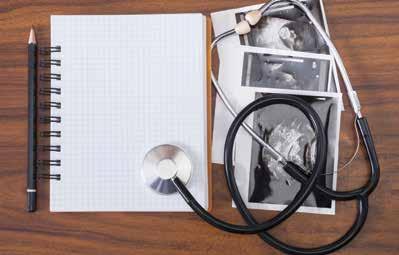
Episiotomies and assisted birth. If your baby is being bashful, your caregiver may wish to perform an episiotomy—an incision between the vagina and anus—or use forceps or vacuum extraction. Discuss the pros and cons of each in advance. C-section. In what circumstances would you want a Ce
sarean to be performed? Does five hours of pushing grant a ticket to the OR or is your baby’s distress the only call for surgery? Discuss this with your physician.
Photos and videos. Do you wish to document every moment from the first twinge through baby’s first bath, or hold the flashbulbs until all are clean and content?
Crowning. Some non squeamish mothers request to have a mirror positioned so they can see the baby crown (when his head first appears) or even reach down and touch his tiny noggin.
Cutting the cord. Indicate when you’d like baby’s um bilical cord to be clamped, and specify whether daddy wants to take part in the snipping ritual.
Post Birth. “After a vaginal delivery, your delivery facil ity may practice placing baby immediately on your chest, known as skin-to-skin. This promotes bonding and suc cessful breast feeding.” For a C-section, indicate who should bond with your baby while you recover.
Nursing. It is recommended to start breastfeeding right away; you can also ask the hospital staff not to offer baby a bottle or pacifier, which could interfere with nursing. Additional info. Mention factors that may affect your delivery, like if you’re blind as a bat without glasses, have gestational diabetes, or wish to bank baby’s cord blood. Don’t forget. While creating a birth plan is a great idea, don’t get so attached to it that you won’t allow any flex ibility in the delivery room. Birth is different for every woman, every time, so no matter how much you plan there’s a good chance things won’t go exactly the way you envisioned them. Remember to expect the unexpected!
52 | Oh BABY!
Oh BABY! | 53
Robe Night Gown Pajamas
Comfy Clothing An Outfit to Leave In Slippers
Bras Several Pair of Comfortable Underwear Socks
Pads/ Nipple Cream
and Makeup Brush and Blow Dryer Glasses/Contact Lenses Chapstick
Ties and Pins
Labor Massage
and Charger
and Charger
Contacts
Card/Info Reduce your stress by packing for your trip to the hospital a few weeks before your expected due date.
Going Home Outfit Onesie/Sleepers Baby Socks Baby Mittens/Hat Baby Finger Nail Clippers Car Seat Receiving Blankets Newborn Diapers and Baby Wipes Call List
Bath
Loose
Nursing
Nursing
Toiletries
Lotion Hair
Pillow Tennis Ball for
Cell Phone
Camera
Music Player/Laptop/Tablet Snacks for Husband/Family Coins for Vending Machine Birth Plan List of Family
Magazines/Books Identification Insurance
Hospital Bag Checklist
Baby
For Mom For
How will I know when I’m in Labor?
Every woman’s labor is different, so pinpointing when yours begins isn’t really possible. However, some specific changes take place in pre-labor, early labor and established (active) labor.
Your body actually starts preparing for labor up to a month before you give birth. You may not recognize the changes at first, but there comes a time that you become aware of these new symptoms as your due date draws near.
In the weeks and days before labor starts, your baby ‘drops’ – you may feel what’s known as ‘lightening’ a few weeks before labor starts. You breathe easier because the heaviness has shifted to your pelvis as opposed to just below your ribcage.
You will have frequent and intense Braxton Hicks contrac tions signaling pre-labor. Your cervix ripens and you’re set for real labor. Some feel crampy (similar to when you had your period).
Those Braxton Hicks contractions are tricky and can strike as often as every ten to twenty minutes. You wonder if you’re in real labor…but real labor contractions are most often lon ger, stronger, closer together, and cause your cervix to dilate.
Your cervix starts to change – it softens and thins out. As your due date draws near, your doctor will do an exam checking to see if your cervix has started to change.
You may pass your mucus plug if your cervix begins to efface significantly or dilate as you get close to labor. This is the plug that has sealed your cervix canal during the last nine months. It can appear as discharge or in a lump. It might have pink, red, or brown blood.
Your water breaks. When the fluid filled amniotic sac sur rounding the baby ruptures, fluid leaks out from your vagina and this is the time to call the doctor. Most women have regular contractions prior to the water breaking (but some times the water breaks first).
In pre-labor or early labor (the latent phase), you may have:
• Persistent lower back pain or abdominal pain, with a pre menstrual feeling and cramps.
• Painful contractions that occur at regular and increasingly shorter intervals, and become longer and stronger in inten sity.
• Broken water. Your membranes may rupture with a gush or a trickle of amniotic fluid. Either way, call your maternity unit
to let them know.
• A brownish or blood-tinged mucus discharge (bloody show). If you pass the mucus plug that blocks the cervix, labor could be imminent, or it could be several days away. It’s a sign that things are moving along.
• An upset tummy or loose bowels.
• A period of feeling very emotional or moody.
• Disrupted sleep.
How you will feel in the pre-labor or early labor phases depends on:
• Whether you’ve had a baby before.
• How you perceive and respond to pain.
• How prepared you are for what going into labor may be like.
When should I call my doctor?
You have probably talked to your doctor about what to do when you think you’re in active labor. But if you’re not sure whether or not the time has come, don’t be embarrassed to call. Doctors are used to getting calls from women who are uncertain if they’re in early labor or active labor, and who need guidance. It’s part of their job.
A doctor can tell a lot by the tone of your voice, so talking helps. She’ll want to know how close together your contractions are, whether you can talk through a contraction, and any other symptoms you may have.
If she thinks you’re still in early labor, she is likely to en courage you to go home until you’re in stronger active labor. Her decision will depend on how you’re coping and whether you’ve got a birth partner to support you.
You should contact your doctor if:
• Your waters break, or if you suspect you’re leaking amniotic fluid.
• Your baby is moving less than usual.
• You have vaginal bleeding (unless it’s just a small amount after a membrane sweep or the blood-tinged mucus of the show).
• You have a fever, severe headaches, changes in your vision, along with abdominal pain.
What should I do early on in labor?
This will depend on what time of day it is, what you like doing, and how you’re feeling. Keeping calm and relaxed will help your body to release the hormone oxytocin that you
54 | Oh BABY!
need for your labor to progress and will help you to cope with the contractions. Do whatever will help you to stay relaxed.

This could mean watching your favorite film, going for a walk, puttering around at home, or asking a trusted friend or relative over to keep you company. You could alternate between walking and resting, or try taking a warm bath or shower to ease any aches and pains. If you can, try to get some rest to prepare you for the work ahead.
During early labor, you may feel hungry, so eat and drink if you feel like it. This will help to comfort you and may even help your labor to progress more smoothly.
Can I have contractions and not be in labor?
Yes. You can have pre-labor contractions. These help your cervix to go through the changes it needs to before it starts to dilate. During dilation, your cervix moves from the back (posterior position) to the front (anterior position). It will also be shortening and thinning (softening and effacing). These changes may take place without you noticing over the last few weeks of your pregnancy. Or you may experience hours or days of cramps or contractions. These may be progressing the early changes in your cervix, even though they may not be dilating your cervix yet. A doctor can confirm whether cervical changes have started during an
examination.
If your baby has his head down but his back to your back, it can take longer for his head to engage and for labor to start. Your contractions may be erratic and low in intensity, and you may have backache.



Your doctor will advise you about ways to cope at home until labor becomes stronger. Try a warm bath or massage to relieve the pain. If your baby is back-to-back, getting into an all-fours position, on your hands and knees, for half an hour or so now and again can help relieve backache.
Can I tell if labor is about to happen soon?
Maybe. Signs of the approach of labor include:
• Lightening, when your baby’s head begins to drop into position in your pelvis. You may be able to breathe more deeply and eat more, but you’ll also need to use the restroom more frequently, and walking may be more difficult.
• Heavier and more mucus vaginal discharge.
• More frequent and noticeably more intense Braxton Hicks contractions.
• Mood swings and a surge of energy.
Oh BABY! | 55
What to Expect at the Hospital: A Guide to Labor and Delivery
Wow! You have made it! The big day has arrived! I’m sure by now that you are ready to sleep without bathroom breaks, fit in to your old clothes, and regain control of your own body functions. Lucky for you the hard part is over, or is it? If you haven’t been in labor before, the first time can be a little scary. You don’t know what to expect. You’re anxious and a little scared. It is not as bad as most (if not all) of the stories you’ve heard.
So, what first? You will have to check in to the hospital once you have confirmed you are in labor. Most hospitals require you to either check in at the Emergency Room or with General Admissions. Once that is completed, you will be moved to Labor and Delivery where you will be asked to change into a hospital gown. Your Labor and Delivery nurse will assess you and the baby to make sure that everything is progressing normally. During this time an IV will be started and a baby heartbeat monitor, a contraction monitor – lots of equipment. Now – you just wait.
Important to know. Stages of Labor:
FIRST STAGE
The first stage really consists of three phases:
Early Phase: This phase typically lasts up to 12 hours although it’s usually considerably shorter for second and subsequent babies. As labor progresses, the contractions get longer and stronger.
Active Phase: Often this phase lasts up to six hours, although it can be a lot shorter. You should be in the hospital or birth center by now or en route. Contractions are much more intense, last about 40 to 60 seconds, and are spaced 3 to 5 minutes apart.
Breathing exercises, relaxation techniques, and coaching are all important now. Pain relief is usually administered in this phase.
Transition Phase: This phase can last anywhere from a few minutes to several hours. Contractions last 60 to 90 seconds and come two or three minutes apart.
SECOND STAGE
The second stage can last from minutes to hours – the average is about an hour for a first-time pregnancy (longer if you’ve had an epidural) – and ends with a moment that’s made up in equal parts of relief and breathtaking beauty: The birth of your baby.
THIRD STAGE
Delivery of the placenta. It’s not over yet! This stage, which begins immediately after the birth of your baby and ends with the delivery of the placenta five to 10 minutes later, is usually anticlimactic, but necessary.
• During the course of your labor, you will be asked to make a lot of decisions.
• Do you want pain medicine?
• If so, will you want an epidural or general pain medication administered through the IV?
• Episiotomy or no episiotomy?
These questions are best answered before you are in labor. Once the pain has started you may not be capable of making the best decisions. Labor can sometimes last for several hours, but there are many techniques that can be used to make these hours pass by a little quicker and easier.
Labor at home as long as possible - You will typically be more comfortable in your own environment with the freedom to move as you need to, and the privacy to act on your instincts to make noise and adjust, no matter how strange the position.
Create a comfortable birthing space - Even in a hospital, you can do small things to make your birthing space more welcoming. Dim lights, aromatherapy/scents you enjoy, pictures, your own blanket and pillow, and your own music can all help the space feel more comfortable. Wearing your own clothes is also something you can do to feel more comfortable.
56 | Oh BABY!
Here are a few ways to make it more bearable:
Move - I am well aware that sometimes in labor all you want to do is lie down, but that position isn’t always the best for encouraging the baby to move down, especially in early labor. In most cultures, women do not lie down to give birth. They stand, squat, hug a tree, basically anything that feels good to them. They don’t tend to spend their labors lying down.
Utilize the water - Ever take a bath to relax? Humans have a natural draw toward water. Most women will report that upon entering a tub in labor, the contractions were much more tolerable. I can tell from personal experience that it definitely takes the edge off. Surround yourself with people that love you and will encourage you - Utilize your partner. At this point they are feeling helpless and useless. Have someone feed you ice chips, fluff your pillow, or massage your feet.
Remove negative energy from the birthing space - If there are spectators in the room who are commenting negatively or making you feel embarrassed or uncomfortable, they should leave the space. There is a lot
of psychology in birth. If you don’t feel comfortable, the labor will take longer and may be harder.
Give in - So many women try to fight the contractions/ pressure waves/rushes in attempt to make them less painful. Give in to the sensations and try to see them more as a rush of energy. They are going to happen no matter what you do. When you give in and let them work, your labor will be more effective and typically quicker.
Remember, at the end of this day you will have a tiny miracle in your hands. That alone will make this day worth every pain you felt!
Some things to have on hand after the baby is born – specifically for the new mom

• Ice packs – in case of tearing during birth or swelling after;
• 2-3 weeks supply of ultra-absorbent sanitary pads;
• Panty liners;
• Hemorrhoid wipes or cream (even if your pregnancy was trouble-free, these can be necessary after labor).
Oh BABY! | 57
Labor Memories
My contractions started on (date/time): At first they felt like: They were this far apart: They lasted this long: The person I called first to tell: His/her reaction: Exciting Moments:
Your Baby’s Birth Story
Birthplace: Time: Date: Length: Weight: Eye Color: Hair Color: Who held baby first? People who were there: Exciting moments:
58 | Oh BABY!
Oh BABY! | 59
Left Hand Left Foot Right Hand Right Foot These Tiny Feet and Hands Tiptoe and Crawl into your Heart and Stay Forever
Introducing the Fur-Babies
area. Dogs are naturally denning animals, so they like small spaces such as crates to retreat to when they are scared or
Make sure the dog’s routine is kept as normal as possible, both when you are in the hospital and when you return home with the new baby. This routine should consist of a feeding schedule (never feed the dog around the baby), a walking schedule, and brief play times without the new baby. Prior to bringing the baby home, have someone bring home something that has the baby’s smell on it, like a blanket or clothing, so the dog can become familiar with the
our children, but their needs are much different than the needs of a human baby. Therefore, it’s important to ensure that you are providing the proper structure that the dog needs before you introduce the new baby to your pet. This is best done with the advice of a professional trainer that has experience in pack structure training.

It is best to make sure your dog knows basic obedience commands like sit, stay, down, leash walking, and coming when called. If your dog doesn’t know these commands, a visit with a professional trainer is in order. When the dog has mastered the obedience commands, use them while doing things you will be doing when the baby comes. Wrap up a doll like a baby and rock it, feed it, and walk around with it. During these practices, periodically reward the dog with treats so that it associates baby activities with something positive. Babies make strange sounds, so help the dog get accustomed to the noises by playing recordings.
Set up a ‘safe’ area for the dog to retreat to when the baby is crying or there’s additional baby commotion. This could be the laundry room, an office, or any other room that will allow the dog to escape and relax. Have water, a crate, sleeping pads, and anything that makes the dog feel secure in the ‘safe’
Be sure to devote the same amount of attention to the dog as before. If you go for a walk with the baby, take the dog. Acclimate your dog to the baby stroller before walking your dog next to it with the baby in it. If you can’t handle the dog and the stroller together, have someone go with you to walk the dog. The dog can be allowed the same household freedom as before, with the exception of the baby’s room, as long as it doesn’t cause any unwanted behavior. Use a gate to prevent the dog from entering the baby’s room without you.
There are no set guidelines as to when a dog will get used to a baby. It could take a few days or a few weeks. It should take less time with proper preparation and good management. If, after several weeks, there has been no sign of unwanted behavior, it unlikely that anything serious will happen. It is good to remember that dogs are still animals so their behavior can never be fully guaranteed. All experts agree that you should never leave a dog unattended with a baby under any circumstances. The sudden movement of a baby could startle the dog and cause unwanted behavior such as biting.
Most dogs will adjust to a new baby without incident. Observe the dog’s behavior for any signs of unwanted behavior or aggression. That way, you can avoid problems and accidents. If you do observe any behavior that is concerning, call a trainer so the problem can be remedied. When introduced properly, with proper preparation, you can have a smooth introduction of your new baby to your old ‘baby’.
60 | Oh BABY!
Dressing your Little One
Look for clothing with easy snap closures at leg inseams. This makes your work go quickly. Slip on pants, shirts with snap closures, and coveralls.
Clothing to Avoid
When buying clothes for your infant make sure seams are smooth and lie flat. Avoid buying clothes with seams that poke out or can easily scratch or irritate the skin.
Another obstacle you want to look out for are tight elastic bands at the arms, legs, neck, and waist. They can constrict your baby, irritate your baby’s skin, and cut off circulation – not good. Check the elastic before purchasing and see how much it gives. Does it stretch enough? If your baby has no room to grow, keep looking! Make sure you go by weight and not by age.

Avoid buttons – they are time consuming and if they come off and can end up in the baby’s mouth.
Comfy and cute are the two ‘C’s every parent should learn when welcoming the little one. You want your baby to get the attention they deserve, that’s a no- brainer for parents; but you also want them to be relaxed and comfortable while enjoying the spotlight. Do babies need all the layers of clothes, big bows, cowboy boots, or even hair fixed to a “tee”? Do babies like it? Is there any way to be “comfy & cute”? Yes – keep it light and keep it casual.
Making Baby Comfy
Cotton is the number one choice for happy babies. An absorbent and breathable fabric, it keeps any baby comfortable. It is one of the most common fabrics for baby clothes. Cotton fabrics are available in organic versions, but make sure you buy two sizes bigger when going organic as organic cotton is typically not preshrunk (it will shrink about 10% after the first wash). Other options are Cotton/Polyester blends & Cotton/Spandex blends.
Prewashed clothing is soft, comfortable, and has gone through the shrinking process.
Fleece is another great choice for parents. A good material for keeping babies warm, it’s often used for baby outerwear and comes in various layers and weights. Fleece is good for the in-between seasons, the fabric isn’t as heavy as most people would think. It’s easy to wash and there are a variety of colors and styles.
Try to avoid metal zippers and rough edges on snaps. Avoid any possible choking hazards (buttons, sequins, etc.) when picking out clothes for your little fashionista.
Looking Cute
Cuteness can come with comfort. Put your baby in the best fabric choice, (including bows, shoes, or anything else) and the smile of a happy baby says it all! Remember, not all fabric is suitable for the skin of an infant. With the right material, you can dress your baby in endless colors, patterns and designs.
TRENDS
• Look for modern updates on classic styles – this can mean colors beyond the imagination or the norm for babies;
• Go Green – clothing made from organic or recycled materials; consider all-natural bamboo clothing as it will adjust to your baby’s temperature and is great for layering;
• Designer Clothing – if you’re going that route, it’s fabulously chic and babies are a market that designers are going for…keep in mind that the outfit will be fleeting – most newborns triple their body weight in a year – outgrowing that chic outfit.
Oh BABY! | 61
Bonding with Baby
Bonding is the intense attachment that develops between parents and their baby. It makes parents want to shower their baby with love and affection and to protect and nourish their little one. Bonding gets parents up in the middle of the night to feed their hungry baby and makes them attentive to the baby’s wide range of cries.

These strong ties between parent and child provide the baby’s first model for intimate relationships, gives them a sense of security, and positive self-esteem. A parents’ responsiveness to an infant’s signals can affect the child’s social and cognitive development. Affection stimulates your child to grow, learn, connect with others, and enjoy life.
Most infants are ready to bond right away and many parents feel an intense attachment right away, while others take a bit longer. Bonding is a process and for many par ents the day to day care of their child creates that bond. You’re overcome with joy and filled with love that your child has just smiled at you…bonding. The more time a mother spends with their baby early on, the quicker mom and baby get to know each other.
Breastfeeding and bottle-feeding are both natural times for bonding. When your baby is nestled against your chest, he can smell your scent and hear your heartbeat –all a part of the bonding process. As you focus on him with no distraction, you come to know his patterns, cries, quirks, needs, and style.
How to Bond:
Respond when your baby cries. Try to understand what he or she is saying to you. You can’t “spoil” babies with too much attention—they need and benefit from a parent’s loving care, even when they seem inconsol able. Hold and touch your baby as much as possible. You can keep him or her close with baby slings, pouches, or backpacks (for older babies). Use feeding and diapering times to look into your baby’s eyes, smile, and talk to your baby. Read, sing, and play peek-a-boo. Babies love to hear human voices and will try to imitate your voice and the sounds you make.
62 | Oh BABY!
Slept through the Night: Smiled: Rolled onto Tummy: Rolled onto Back: Laughed: Blew a Kiss: Sat and Played with Toy: Waved Bye-Bye: Held a Bottle: Held a Cup: Ate Baby Food: Held a Toy: Crawled: Danced: Had a Haircut: Clapped Hands:_____________________________________________________________________________________
Oh BABY! | 63
___________________________________________________________________________ Walked:____________________________________________________________________________________________ Went on an Outing:______________________________________________________________________________ Played Peek-a-Boo:____________________________________________________________________ Stood Alone:________________________________________________________________________ Spoke First Word:________________________________________________________________________ Other Unforgettable Moments:__________________________________________________________ Baby Milestones
Made a Sound:
Getting your Body Back
Dedication, patience, and perseverance are what every mom needs to get that pre-baby body back! If you want it, go for it, but get it back the healthy way!
Here’s a few things every “new mom” needs to know about getting back into shape after baby.

Forget about the celebrities who look like they were never pregnant just weeks after the baby! Let’s just say it’s not realistic, nor is it healthy – ask any expert. Celebrities statistically do not gain as much weight during their pregnancies as average women, they have resources the average women doesn’t have, and many of them go on crazy diets (wrong!).
The worst thing you can do is try to do too much too soon. So, for the first six weeks after birth – DO NOT go on a diet – especially if you are breast-feeding. Your baby needs the nutrients and you need the energy.
“You should be eating at least 1,800-2,000 calories a day while breastfeeding, and if you eat less you will not only be shortchanging yourself, you’ll be shortchanging your baby. You can’t produce quality milk if you are not eating enough,” says nutritionist Elizabeth Somer, RD, author of Nutrition for a Healthy Pregnancy.
“If you can lose a couple of pounds before then, that’s OK, but you really don’t want to cut your food intake dramatically during these early weeks. You need the energy, and you need the calories for breastfeeding,” she says.
Awesome news: Breastfeeding burns calories! It can help mothers lose extra weight gained during pregnancy and if you’re not breastfeeding, Somer says, it’s OK to watch your caloric intake, but never aim to lose more than a pound a week. “Pregnancy is not unlike running a marathon every day for nine months. You have put your body through the wringer. So even if you ate well, several nutrients are still likely to be compromised. You need this postpartum time to restore your nutritional status and your energy,” she says. Exercise is highly recommended, it can not only help you whip into shape but also increase energy and may even reduce risks of postpartum depression.) Exercise is a key factor in the health of new moms, but before you start your exercise please ask your
doctor if you’re ready (if you had a difficult pregnancy and/or complicated delivery especially)
Most doctors will say start whenever you feel ready and work up your activity, if you can’t keep up with any program you do decide to start, you’re probably not ready or the program could be too extreme.
Walking is a great recommendation, go on some stroller routes and the baby would love it too, you’ll get that one on one time with your little one, while getting exercise so it’s a win-win!
Don’t be in such a hurry to lose baby fat, be cautious about any exercise that puts major stress on your joints- examples like jogging, jumping, running. You could end up on the sideline for months with serious injuries.
As exercising pay close attention to these warning signs and seek medical attention if they appear:
Excessive bleeding, pelvic or abdominal pain, extreme shortness of breath, exhaustion even after mild exercise, muscle soreness that does not go away in a day or two.
Besides that have fun, eat good and love your momma body!
64 | Oh BABY!
Tip: If you didn’t have a C-Section you could also focus on core workouts!
Vaccine Tracker
This immunization schedule is recommended by the Centers for Disease Control and Prevention. If You’d like to try a modified schedule, speak with your pediatrician.
Vaccine
Hepatitis B
Diptheria, Tetanus, Pertussis Haemophilus Influenza Type B Inactivated Poliovirus
Measles, Mumps, Rubella Varicella Meningococcal
Pneumococcal
Influenza
Hepatitis A Rotavirus HPV
Birth 1 mo. 2 mos. 4 mos. 6 mos. 12 mos. 15 mos. 18 mos. 24 mos. 4-6 yrs. 11-12 yrs yearly
Oh BABY! | 65
Baby’s First Birthday
Your baby is turning 1 and that’s worth celebrating! Of course, you want to have a first birthday party in honor of his special day. But how do you plan for such an important occasion? How do you make sure that your baby’s first birthday is a won derful time for both you and him? These top twelve do’s and don’ts will point you in the right direction.
DO keep the birthday party simple. Your baby won’t really comprehend what all the fuss is about. This day is for you to enjoy and to celebrate the amazing child that has transformed your life. Just don’t overcomplicate anything this allows you to be free to relish every moment.
DON’T struggle over finding the perfect theme for the party. Your 1 year old won’t notice. Next year, he/she may be begging you for Cinderella, Elsa, Wonder Pets, Dora the Explorer, Thomas the Train theme, but this year you can do whatever makes sense for you.
DO make the party short. An hour or so is enough excitement for a 1 year old. Any longer than 2 hours and he/she might go into celebration overload.
DO schedule the birthday party for a time when your baby is

less likely to be tired and cranky. If he/ she usually takes an early afternoon nap, then a late afternoon party is best.
DON’T invite too many people. A room full of strangers crowd ing around your little one can be overwhelming. Choose close friends and relatives to share this special day.
DO have the party at home, if possible. This is the place your baby feels most secure. There will be a lot of activity that day that he/she doesn’t quite understand. So, it’s important for him/ her to feel comfortable and safe in the midst of all the strange birthday festivities.
DO keep your eyes open for potential dangers. If a balloon pops, make sure you put it in the trash immediately, because it could become a choking hazard.
DON’T serve food that is challenging to eat. Finger foods are best for little ones. And adults like them too!
DO have a birthday cake or cupcakes. It is fun for everyone to watch your 1 year old eat his first birthday cake, and a great photo opportunity. Just watch out for your baby and the lit candle.
DO consider invitations and favors that are personalized with your child’s photo. Most of your guests for this birthday party will be adults who have loved and supported you and your baby through the first year. Grandmothers, aunts, and other friends and loved ones will be thrilled with a keepsake featur ing a picture or pictures of the birthday boy or girl.
DON’T forget to charge the camera batteries or take tons of photos. You may be busy and preoccupied with the celebra tion, but your 1 year old won’t remember the party, so you’ll want to make sure you document every moment – assign some one this task. A nice tip is to send out photo thank you notes after the party.
DO create a first birthday memory book after the party. This is a great future gift you can give to your child. Take photos of the cake, decorations, guests, and of course, him/her. You can put these photos in a photo album or make a scrapbook, complete with journaling your thoughts about his special day. Include a page where each guest writes something special to your 1 year old.
Simplify, relax and enjoy this special day. Your baby’s first birthday party is a milestone that comes along only once in his/ her life, so cherish every wonderful moment.
66 | Oh BABY!
What Do My Parents Think Today? Say it in a Saysentence... it in a word...
Year 1: Year 2: Year 3: Year 4: Year 5: Year 6: Year 7: Year 8: Year 9: Year 10: Year 11: Year 12: Year 13: Year 14: Year 15: Year 16: Year 17: Year 18:
Oh BABY! | 67
Baby’s First Tooth
Your baby’s primary teeth (baby teeth) are quite important. Decay and/or loss of these teeth can jeopardize the proper development of the permanent teeth. It is recommended that you take your child to the dentist for his first dental examination, cleaning, and topical fluoride treatment at his first birthday.
For most babies, that first tooth starts coming in between 4 and 8 months. Girls tend to get teeth faster than boys. Occasionally, some newborns are born with teeth. These are usually extra and should be examined by a children’s dentist. The dentist may remove these teeth in order to prevent problems with feeding and damage to the newborn’s tongue.
Babies get teeth at different rates. Baby teeth generally come in pairs, and as long as your baby starts to get teeth before 18 months, you probably don’t need to worry. When teeth come in, most babies experience pain and can be cranky and fussy. Common signs of teething include sore, tender, and swollen gums; excessive drool; loss of appetite; difficulty sleeping; and a low-grade fever. Babies may be clingy and chew on their fingers and toys. They may break out in a rash or their face, neck, and chest due to the excessive drool.
When Teeth Come In:
Central incisors – 6 to 8 months.
Lateral incisors – 7 to 9 months.
Cuspids – 16 to 18 months.
First molars – 12 to 14 months.
Second molars – 20 to 24 months.
After your baby’s teeth begin to come in, you’ll need to take care of them. Use a piece of wet gauze to wipe them off or a toothbrush if necessary – do this twice per day. Don’t use toothpaste until they are older.
If your baby does not have teeth at 18 months, talk to your physician. There may be an underlying problem, such as hypopituitarism or hypothyroidism that is causing the delay and these need to be addressed.

By the time they turn 4 years of age, your child should have a full mouth of baby teeth – 20 to be exact. As guides for permanent teeth, baby teeth are important and should be taken care of – brushing, flossing, and visiting the dentist.
Breast-Feeding and Bottle Feeding
Whether to breast-feed or bottle feed is an important concern of the new mother. Consultation with your pediatrician will result in the decision that is best for you and your baby. If the bottle is used, the type of nipple will have no significant effect on your baby’s bite. However, after the eruption of the first tooth (4 to 8 months), allowing the infant to nurse from the breast or the bottle for extended periods of time can have destructive effects on the teeth. Most children will complete their nutritional requirements at mealtime. Children who continue to bottle feed while napping, sleeping, or in-between meals past 6 months of age, run the risk of developing extensive tooth decay. Even breast milk can cause infant tooth decay. The most damaging bottle contents are fruit juices like apple or grape, citrus juices like orange or lemon, and sweetened beverages. Carbonated drinks and sugar or syrup-sweetened water are also dangerous. Sleeping with
68 | Oh BABY!








Oh BABY! | 69
Baby’s Tooth Chart
Date of Eruption
Date of Eruption
Date of Eruption
Date of Eruption
Date of Eruption
Date of Eruption
Date of Eruption
Date of Eruption
Date of Eruption
Date of Eruption
Date of Eruption
Date of Eruption Date of Eruption Date of Eruption
UPPER LOWER
Date of Eruption
Date of Eruption Date of Eruption Date of Eruption Date of Eruption
Date of Eruption
70 | Oh BABY!
A. Central
B. Lateral
C.
D. First Molar E. Second Molar
E E D C B AA B C D E D C B AA B C D E
Incisor
Incisor
Cuspid
UPPER LOWER
Baby’s First Tooth
a bottle should never be allowed to start. If the child must sleep with a bottle, then it should contain water only. If your child has been sleeping with a bottle or does have a daytime bottle habit, you should arrange for a pediatric dental examination as soon as hospital.
Pacifiers
It is recommended that the baby be weaned from the bottle or breast at about one year of age. If the baby still has a continued need to suck, a pacifier may be used. The most important consideration in selecting a pacifier is safety. It should be one with a large handle which will not separate.
Thumbsucking
Thumbsucking at an early age is very common and while continued thumbsucking can lead to deformation of the upper front part of the mouth, it is not advisable for parents to attempt to terminate the habit. Bribes and
threats will do little to correct the habit and often enhance the anxiety and guilt your child may have. Some children will discontinue thumbsucking by themselves, often when they start pre-school or kindergarten. For those who do not, most habits can be successfully corrected with the help of the pediatric dentist when, and only when, the child indicates a desire to stop.
Teething
The first tooth will usually erupt between the ages of 4 to 8 months. Teething can be a most disturbing time for new parents, but this is a normal process in the child’s development. Although often the subject of debate between physicians, pedodontists, and parents, there is some evidence to suggest that certain other findings, such as a rise in temperature, diarrhea, increased salivation/ drooling, rashes, and changes in the bowel habits, can occur in conjunction with teething. The use of teething

Oh BABY! | 71
Tracking Your Baby… Developmental Milestones
The First Month:
•Can lift head momentarily
•Turns head from side to side when lying on back
•Hands stay clenched
•Strong grasp reflex present
•Looks and follows object moving in front of them in range of 45 degrees
•Sees black and white patterns
•Quiets when a voice is heard
•Cries to express displeasure
•Makes throaty sounds
•Looks intently at parents when they talk to him/her
The Second Month:
•Lifts head almost 45 degrees when lying on stomach
•Head bobs forward when held in sitting position
•Grasp reflex decreases
•Follows dangling objects with eyes
•Visually searches for sounds
•Makes noises other than crying
•Cries become distinctive (wet, hungry, etc.)
•Vocalizes to familiar voices
•Social smile demonstrated in response to various stimuli
Red flags:
Each child develops at her own pace, but talk to your baby’s doc tor if your 1-month-old:
•Feeds slowly or doesn’t suck well
•Doesn’t seem to focus her eyes or watch things moving nearby
•Doesn’t react to bright lights
•Seems especially stiff or floppy
•Doesn’t respond to loud sounds
The Third Month:
•Begins to bear partial weight on both legs when held in a standing position
•Able to hold head up when sitting but still bobs forward
•When lying on stomach can raise head and shoulders between 45 and 90 degrees
•Bears weight on forearms
•Grasp reflex absent
•Holds objects but does not reach for them
•Clutches own hands and pulls at blankets and clothes
•Follows objects 180 degrees
•Locates sound by turning head and looking in the same direction
•Squeals, coos, babbles, and chuckles
•“Talks” when spoken to
•Recognizes faces, voices, and objects
•Smiles when he/she sees familiar people, and engages in play with them
•Shows awareness to strange situations
Red flags
Each child develops at his own pace, but talk to your child’s doc tor if your 3-month-old:
•Can’t support his head well •Can’t grasp objects
•Can’t focus on moving objects •Doesn’t smile
•Doesn’t react to loud sounds •Ignores new faces •Seems upset by unfamiliar people or surroundings
The Fourth Month:
•Drooling begins •Good head control
•Sits with support
•Bears some weight on legs when held upright •Raises head and chest off surface to a 90 degree angle
•Rolls from back to side •Explores and plays with hands •Tries to reach for objects but overshoots •Grasps objects with both hands •Eye-hand coordination begins •Makes consonant sounds •Laughs •Enjoys being rocked, bounced or swung
The Fifth Month: •Signs of teething begin •Holds head up when sitting •Rolls from stomach to back •When lying on back puts feet to mouth •Voluntarily grasps and holds objects •Plays with toes
•Takes objects directly to mouth •Watches objects that are dropped •Says “ah-goo” or similar vowel-consonant combinations •Smiles at mirror image •Gets upset if you take a toy away •Can tell family and strangers apart •Begins to discover parts of his/her body
The Sixth Month:
•Chewing and biting occur •When on stomach, can lift chest and part of stomach off the surface, bearing weight on hands •Lifts head when pulled to a sitting position •Rolls from back to stomach •Bears majority of weight when being held in a standing position •Grasps and controls small objects
•Holds bottle
•Grabs feet and pulls to mouth
72 | Oh BABY!
•Adjusts body to see an object
•Turns head from side to side and then looks up or down
•Prefers more complex visual stimuli
•Says one syllable sounds like “ma”, “mu”, “da”, and “di”
•Recognizes parents
Red flags:
Each child develops at her own pace, but talk to your child’s doc tor if your baby:
•Seems very stiff or floppy
•Can’t hold her head steady •Can’t sit on her own
•Doesn’t respond to noises or smiles
•Isn’t affectionate with those closest to her •Doesn’t reach for objects
The Seventh Month:
•Sits without support, may lean forward on both hands
•Bears full weight on feet
•Bounces when held in standing position
•Bears weight on one hand when lying on stomach
•Transfers objects from one hand to another
•Bangs objects on surfaces
•Able to fixate on small objects
•Responds to name
•Awareness of depth and space begin
•Has taste preferences
•“Talks” when others are talking
Red flags:
•Seems very stiff or floppy
•Can’t hold her head steady
•Can’t sit on her own
•Doesn’t respond to noises or smiles
•Isn’t affectionate with those closest to her •Doesn’t reach for objects
The Eight Month:
•Sits well without support
•Bears weight on legs and may stand holding on to furniture
•Adjusts posture to reach an object
•Picks up objects using index, fourth, and fifth finger against thumb
•Able to release objects
•Pulls string to obtain object
•Reaches for toys that are out of reach
•Listens selectively to familiar words
•Begins combining syllables like “mama” and “dada” but does not attach a meaning
•Understands the word no (but does not always obey it)!
•Dislikes having diaper changed and being dressed
The Ninth Month:
•Begins crawling
•Pulls up to standing position from sitting
•Sits for a prolonged time (10minutes)
•May develop a preference for use of one hand
•Uses thumb and index finger to pick up objects
•Responds to simple verbal commands
•Comprehends the word “no”
•Increased interest in pleasing parents
•Puts arms in front of face to avoid having it washed
The Tenth Month:
•Goes from stomach to sitting position
•Sits by falling down
•Recovers balance easily while sitting
•Lifts one foot to take a step while standing
•Comprehends “bye-bye”
•Says “dada” or “mama” with meaning
•Says one other word beside “mama” and “dada” (hi, bye, no, go)
•Waves bye-bye
•Object permanence begins to develop
•Repeats actions that attract attention
•Plays interactive games such a “pat-a-cake”
•Enjoys being read to and follows pictures in books
The Eleventh Month:
•Walks holding on to furniture or other objects
•Places one object after another into a container
•Reaches back to pick up an object when sitting •Explores objects more thoroughly •Able to manipulate objects out of tight fitting spaces •Rolls a ball when asked •Becomes excited when a task is mastered •Acts frustrated when restricted •Shakes head for “no”
The Twelfth Month:
•Walks with one hand held •May stand alone and attempt first steps alone •Sits down from standing position without help •Attempts to build two block tower but may fail •Turns pages in a book
•Follows rapidly moving objects •Says three or more words other than “mama” or “dada” •Comprehends the meaning of several words •Repeats the same words over & over again •Imitates sounds, such as the sounds dogs and cats make •Recognizes objects by name
•Understands simple verbal commands •Shows affection
•Shows independence in familiar surroundings
•Clings to parents in strange situation
•Searches for object where it was last seen
Red flags:
•Doesn’t crawl
•Seems to drag one side while he’s crawling for a month or more •Can’t stand with support •Doesn’t try to find objects you’ve hidden in front of him •Doesn’t say any words •Doesn’t use gestures, such as shaking his head “no” and pointing
Oh BABY! | 73
1 and 2 Month Checkup
You can expect your baby’s doctor to: Weigh and measure your baby to make sure she’s growing at a healthy rate. Do a complete physical.
Probably give your baby a hepatitis B shot. Recommend vitamin D drops for breastfed babies. Address any other concerns.
How is your baby sleeping? What position does she sleep in?
How often is your baby eating?
What are your baby’s bowel movements like?
Does she quiet down, at least briefly, at the sound of your voice?
Is your baby awake for longer periods of time?
Does she make soft cooing noises when content and alert?
Have you noticed anything unusual about your baby’s eyes or the way she looks at things?
Is she a little fussier at the end of the day?
Are you giving your baby tummy time when she’s awake?
Does your baby hold her head up when she’s placed on her tummy?
How are you doing?
Notes:
74 | Oh BABY!
4 and 6 Month Checkup
You can expect your baby’s doctor to: Weigh and measure your baby to make sure she’s growing at a healthy rate. Do a complete physical.
Probably give your baby a hepatitis B shot. Recommend vitamin D drops for breastfed babies. Address any other concerns.
How is your baby sleeping? What position does she sleep in?
How often is your baby eating?
What are your baby’s bowel movements like?
Does she quiet down, at least briefly, at the sound of your voice?
Is your baby awake for longer periods of time?
Does she make soft cooing noises when content and alert?
Have you noticed anything unusual about your baby’s eyes or the way she looks at things?
Is she a little fussier at the end of the day?
Are you giving your baby tummy time when she’s awake?
Does your baby hold her head up when she’s placed on her tummy?
How are you doing?
Notes:
Oh BABY! | 75
9 and 12 Month Checkup
You can expect your baby’s doctor to: Weigh and measure your baby to make sure she’s growing at a healthy rate. Do a complete physical.
Probably give your baby a hepatitis B shot. Recommend vitamin D drops for breastfed babies. Address any other concerns.
How is your baby sleeping? What position does she sleep in?
How often is your baby eating?
What are your baby’s bowel movements like?
Does she quiet down, at least briefly, at the sound of your voice?
Is your baby awake for longer periods of time?
Does she make soft cooing noises when content and alert?
Have you noticed anything unusual about your baby’s eyes or the way she looks at things?
Is she a little fussier at the end of the day?
Are you giving your baby tummy time when she’s awake?
Does your baby hold her head up when she’s placed on her tummy?
How are you doing?
Notes:
76 | Oh BABY!
Parenting
All parents make mistakes and you will find that parenthood – especially new parenthood comes with a fear that you just ‘don’t want to mess it up’…The truth is no one is infal lible – especially new parents. Parenting is one of the most difficult and time-consuming aspects of a person’s life – the daily needs of a child, developing skills, language, appro priate behaviors, and so much more…it’s exhausting and probably the most rewarding thing you will ever do.
A Parenting class or classes that provide a parent with skills, tips, and strategies for dealing with a new baby and com mon parenting challenges can be one of the best things you do before your baby comes in to the world.
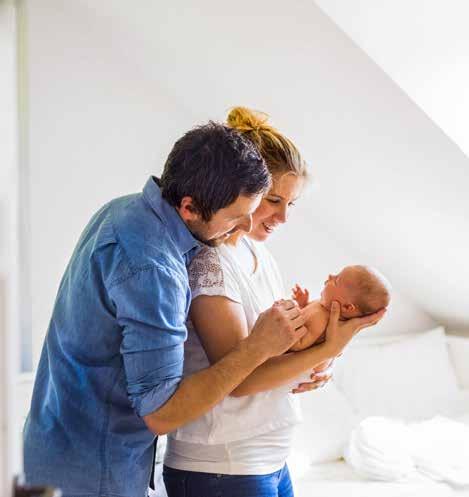
A parenting class can build the foundation of a strong and deeply committed relationship – and ultimately a strong and trusting child.
ALL INFANTS:
• Love to explore the world around them, so you have to make your home safe.
• Have their own personalities, which may be different from their parents’.
• Put new and stressful demands on parents, so parents may need to ask for help.
• Need routines that match their unique abilities, and parents may need to adjust their sched ules to fit this new individual.
Your baby is now smiling and cooing and will soon start to move around more. These are signs of your baby’s personality and the start of a lifelong learn ing process.
By age 3 or 4 months, infants are drooling and chewing on the things they put into their mouths. This is how they learn about the world around them.
You may notice that your baby is becoming inter ested in everything within reach, especially simple toys with bright colors and those that make noise. Even tiny infants act in very individual ways. Some are loud and active, others are quiet and passive. Some are easygoing and cuddly, others are more serious. Some are relaxed, others are more highstrung. As a parent, you start to know your baby’s unique personality.
THINK ABOUT THIS PERSONALITY WHEN YOU ARE CAR ING FOR YOUR BABY.
• If your baby is naturally fussy and has difficulty calming down, avoid too much stimulation.
• If your baby is sensitive to changes in routines, make sure that your days are not too busy or filled with lots of changes. If your baby’s personality is different from yours, remember that what makes your baby comfort able and happy may not feel right for you.
AS INFANTS GET OLDER, THEY:
• Begin to roll over.
• Reach for toys, spoons, and other objects.
• They want to sit up.
This is the beginning of independence, but babies do not know what might put them in danger. Keeping your baby in a safe place, such as in a crib or in a playpen, will prevent falls, burns, poisoning, choking, and other injuries. Child proofing your home can also help keep your baby safe.
Oh BABY! | 77






78 | Oh BABY!




















Oh BABY! | 79

80 | Oh BABY!




























































































































